LANGUAGE IN INDIA
Strength for Today and Bright Hope for Tomorrow
Volume 2 : 6 September 2002
Editor: M. S. Thirumalai, Ph.D.
Associate Editors: B. Mallikarjun, Ph.D.
Sam Mohanlal, Ph.D.
B. A. Sharada, Ph.D.
Ph.D. Dissertation
A Contrastive Analysis of Hindi and Malayalam
V. Geethakumary, Ph.D.
© V. Geethakumary 2002. E-mail:geethakumary@hotmail.com Ph.D. in Linguistics, Awarded by the University of Kerala, 1997. Guide: Dr.G.K.Panikkar. Click HOME PAGE of Language in India for the current issue articles. Click BACK ISSUES for previous issues.
CHAPTER TWO
PHONOLOGY
| 2.1 | Vowels | 2.1.1 | Front vowels |
| 2.1.1.1 | Malayalam | 2.1.1.2 | Hindi |
| 2.1.1.3 | Similarities and dissimilarities | 2.1.2 | Central vowel |
| 2.1.2.1 | Malayalam | 2.1.2.2 | Hindi |
| 2.1.2.3 | Similarities and dissimilarities | 2.1.3 | Back vowels |
| 2.1.3.1 | Malayalam | 2.1.3.2 | Hindi |
| 2.1.3.3 | Similarities and dissimilarities | 2.2 | Consonants |
| 2.2.1 | Stops | 2.2.1.1 | Malayalam |
| 2.2.1.2 | Hindi | 2.2.1.2 | Similarities and dissimilarities |
| 2.2.2 | Nasals | 2.2.2.1 | Malayalam |
| 2.2.2.2 | Hindi | 2.2.2.3 | Similarities and dissimilarities |
| 2.2.3 | Laterals | 2.2.3.1 | Malayalam |
| 2.2.3.2 | Hindi | 2.2.3.3 | Similarities and dissimilarities |
| 2.2.4 | Trills | 2.2.4.1 | Malayalam |
| 2.2.4.2 | Hindi | 2.2.4.3 | Similarities and dissimilarities |
| 2.2.5 | Fricatives | 2.2.5.1 | Malayalam |
| 2.2.5.2 | Hindi | 2.2.5.3 | Similarities and dissimilarities |
| 2.2.6 | Semivowels | 2.2.6.1 | Malayalam |
| 2.2.6.2 | Hindi | 2.2.6.3 | Similarities and dissimilarities |
| 2.3 | Clusters | 2.3.1 | Initial clusters |
| 2.3.1.1 | Malayalam | 2.3.1.2 | Hindi |
| 2.3.1.3 | Similarities and dissimilarities | 2.3.2 | Medial clusters |
| 2.3.2.1 | Malayalam | 2.3.2.2 | Hindi |
| 2.3.2.3 | Similarities and dissimilarities | 2.3.3 | Final clusters |
| 2.3.3.1 | Malayalam | 2.3.3.2 | Hindi |
| 2.3.3.3 | Similarities and dissimilarities | 2.4 | Syllabic structures |
| 2.4.1 | Monosyllabic | 2.4.1.1 | Malayalam |
| 2.4.1.2 | Hindi | 2.4.1.3 | Similarities and dissimilarities |
| 2.4.2 | Polysyllabic | 2.4.2.1 | Malayalam |
| 2.4.2.2 | Hindi | 2.4.2.3 | Similarities and dissimilarities |
| 2.5 | Supra-segmental features | 2.5.1 | Intonation |
| 2.5.1.1 | Malayalam | 2.5.1.2 | Hindi |
| 2.5.1.3 | Similarities and dissimilarities | 2.5.2 | Juncture |
| 2.5.2.1 | Malayalam | 2.5.2.2 | Hindi |
| 2.5.2.3 | Similarities and dissimilarities |
CHAPTER II
PHONOLOGY
2.1 Vowels
| Malayalam | Hindi | |
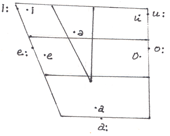 |
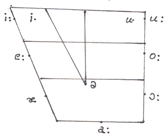 |
|
| /~/ Simultaneous nasal release of vowels |
2.1.1 Front Vowels
2.1.1.1 Malayalam
The front vowels in Malayalam are / i, i:, e, e:/. Of these two are short vowels /i,e/ and two are long vowels /i:, e:/. The four front vowels have an on glide ‘y’ in the initial position and an off glide of ‘y’ in the final position. This general statement is not repeated in the allophonic statement. Their allophones and their distribution are as follows (Velayudhan Asari 1970).
/i/ High front unrounded tense vowel.
[I] Lower high front unrounded vowel occurs in the environment c-c.
E.g. /tinnu/ [tInnu] ‘ate’
[i] High front unrounded tense vowel occurs elsewhere.
E.g. / iTi/ [iDi] ‘hit’
/ kiaLi/ [kaLi] ‘play’
2. /i:/ High front unrounded tense long vowel.
[i:] High front unrounded tense long vowel occurs initially, medially and finally.
E.g. /i:cca/ [i:c:a] ‘fly’
/mi:in/ [mi:n] ‘fish’
/ni::/ [ni:] ‘you
3. /e/ Higher-mid front unrounded short vowel.
[Σ] meanmid front unrounded vowel occurs in the environment c-c.
E.g /peTTi/ [pΣT:i] ‘box’
/vellam/ [vΣL:am] ‘water’
[e] Highermid front unrounded short vowel occurs elsewhere.
E.g. /eli/ [e:li] ‘rat’
/enRe/ [enRe] ‘mine’
4. /e:/ Highermid front unrounded long vowel.
/e:/ Highermid front unrounded long vowel occurs initially, medially and finally.
E.g /e:Ni/ [e:Ni] ‘ladder’
/pe:Ti/ [pe:Ti] ‘fear’
/po:re:/ [po:re:] ‘(is it) not enough’?.
2.1.1.2. Hindi
In Hindi all the vowels which are preceded or followed by a nasal consonant are generally nasalized. This general statement is not repeated in the allophonic distribution.
Front vowels in Hindi are /i, i:, e:, æ:/
Their allphonic distribution is as shown below.
(Chaturvedi, 1973)
1. /i/ High, front, unrounded short vowel.
[Ĭ] extra short vowel occurs word initially before s+c, word finally and elsewhere after c1+c2.
E.g. /iste:ma:l/ [Ĭste.ma:l] ‘use’
/priy/ [prĬy] ‘beloved’
/pra:pti/ [pra:ptĬ/ ‘ability’
[i] Lower-high front little centralized short vowel occurs elsewhere.
e.g. /itiha:s/ [itiha:s] ‘history’
/niša:n/ [niša:n/ ‘any mark’
/i:/ High front, unrounded long vowel.
[i:] High, front, unrounded long vowel occurs word finally.
e.g. /k>bhi:/ [k>bhi:] ‘sometimes’
/k>cci:/ [k>c:i:] ‘unripe’
[i.] High front unrounded half long little centralized vowel occurs everwhere
e.g /ka:ri:g>r/ [ka:ri.g>r] ‘craftsman’
/i:ma:nda:r/ [i.ma:nda:r] ‘intelligent’
3. /e:/ Lower-mid front unrounded long vowel.
[e:] Lower-mid front unrounded long vowel occurs initially.
e.g. /e:v∂m/ [e:v∂m’] ‘thus’
/e:k/ [e:k’] ‘one’
[e’] Little centralized lower mid half long vowel occurs elsewhere
e.g. /ke:le/ [ke.le.] ‘fruits’
/je’b/ [je’b’] ‘pocket’
4. / æ: / Higher low, front unrounded long vowel.
[ æ:] Higher low, front unrounded long vowel occurs initially.
e.g. / æ:sa:/ [æ:sa:] ‘like that’
/ æ:ky/ [æ:k’y’] ‘unity’
[ æ·] Higher low, front unrounded little centralized, half long vowel occurs elsewhere except before y.
E.g. /mæ:da:n/ [mæ·da:n’] ‘playground’
/kæ:sa:/ [kæ·sa:] ‘what kind of’
[∂I] a diphthong beginning with [∂] and gliding of towards [ I] occurs when followed by /y/.
E.g. /bh∂:ya:/ [bh∂Iya:] ‘brother’
/m∂:ya:/ [m∂Iya:] ‘mother’
2.1.1.3. Similarities and dissimilariaties
The front vowels /i:, e:/ show similarity in both Malayalam and Hindi.
e.g.
M H
/i:cca/ [i:c:a] ‘fly’ /i:švar/ [i:švar] ‘God’
/mi:n/ [mi:n] ‘fish’ /abhi:/ [abhi:] ‘now’
/e:Ni/ [e:Ni] ‘ladder’ /e:k/ [e:k’] ‘one’
/me:Tam/ [me:D??m]‘name of /gale/ [gale’] ‘'neck
the month’
The front short vowel /i/ show partial similarity. When compared with the Malayalam /i/ Hindi /i/ is a little centralized and extra short.
e.g.
M H
/iTi/ [iDi] `hit’ /iste:ma:1/ [Iste:ma:1] `use’
The front short vowel /e/ is found only in Malayalam.
The vowel /æ:/ is found in Hindi only.
2.1.2. Central Vowels
2.1.2.1 Malayalam
The central vowels in Malaylam are /∂, a, a: /. Their allophonic distributions are as follows.
1) /∂ / Mean - mid central unrounded vowel.
[∂] Mean-mind central unrounded vowel occurs word finally.
Eg: / ka:l∂ / [ka:l∂] `leg’
/ va:l / [va:l∂] `tail’
2. /a/ Low central unrounded short vowel.
/∂˘/ Low central unrounded vowel occurs in the
e.g. /karam/ [kar∂˘m] `tax’
/maram/ [mar∂˘m] `tree’
[a] Low back unrounded vowel occurs elsewhere.
e.g. /kaTa/ [kaDa] `shop’
/vaTam/ [vaD∂˘m] `rope’
3. /a:/ Low central unrounded long vowel.
[a:] Low central unrouinded long vowel occurs word initially, medially and finally.
e.g. /a:na/ [a:na] `elephant’
/vima:nam/ [vima:n∂˘m] `aeroplane’
/va:/ [va:] `come’
2.1.2.2 Hindi
The two central vowels in Hindi are /∂, a:]. Their allophonic distribution is shown below.
1) /∂ / Mean -mind, central unrounded vowel.
[Σ ] Mean -mid front more centralized unrounded short vowel occurs before /h/ + /c/ or before final /h/ or before /h/ not followed by a vowel.
e.g. /k∂hna/ [kΣhna:] `to say’
/v∂gæ:r∂h/ [v∂gæ:rΣh] `etc’
/r∂hna:/ [rΣhna:] `stay’
[∂] Mean-mid central unrounded short vowel occurs elsewhere.
e.g. /∂bhi:/ [∂bhi: ] `now’
/ ∂b’/ [∂,b’] `now’
2) /a:/ Low central unrounded long vowel.
[a:] Low central unrounded long vowel occurs initially and medially.
Eg: /a:j/ [a:j’] `today’
/ka:l] [ka:1’] ‘time’
[a•] Low central, little higher than [a:] half long occurs elsewhere.
Eg: /ka:la:/ [ka:la•] `black’
/kha:ta:/ [kha:ta•] `granary’
2.1.2.3 Similarities and dissimilarities
The central vowel /a:/ is similar in both Malayalam and Hindi.
E.g.
M H
/a:na/ [a:na] `elephant’ /a:j/ [a:j’] `today’
/vima:nam/ [vIma:n∂˘m] `aeroplane’ /ka:l/ [ka:1’] ‘time’
The vowel phoneme /a/ of Malayalam is partially similaar to Hindi phoneme /∂/. Both of them are central unrounded vowels with difference in tongue height. /a/ in Malayalam is low and /∂/ in Hindi is high as exemplified below:
/kaTa/ [kaDa] `shop’ /kal/ [ka1’] `yesterday/tomorrow’
The vowel phoneme /∂/ which is a central unrounded vowel is found only in Malayalam.
2.1.3 Back vowels
2.1.3.1. Malayalam
The four back vowels in Malayalam are /u, u:, o, o:/. These vowels have an on glide of `w’ initially and an off glide of `w’ finally. This general statement is not repeated in the allophonic statements.
1. /u/ High back rounded short vowel.
[υ] High back unrounded vowel occurs in the environment c-c except in word initial syllables.
E.g: /kotuk∂/ [kotυg∂] `mosquito’
/kaTuk∂/ [kaDυg∂] `mastard seed’
[u] High back rounded tense vowel occurs elsewhere.
E.g: /umi/ [u:mi/ `husk’
/kuTam/ [kuD∂˘m] `pot’
2. /u:/ High back rounded long vowel occurs word initially, medially and finally.
E.g: /u:ma/ [u:ma/ `dumb’
/ku:Ta/ [ku:Da] `basket’
/varu:/ [varu:] `come (please)’
3. /o/ Higher -mid back rounded vowel.
[o] Higher -mid back rounded short vowel occurs word initially and medially.
E.g: /oruma/ [oruma] `unity’
/koTi/ [koDi] `flag’
4. /o:/ Higher - mid back rounded long vowel.
[o:] Higher -mid back rounded long vowels occurs word initially, medially and finally.
E.g: /o:Lam/ [o:L∂˘m/ `ripples’
/to:Ni/ [to:Ni] ‘small boat’
/po:/ [po:] `go’
2.1.3.2 Hindi
The back vowels in Hindi are / u, u: o:, >: /. Their allophonic distributions are as follows:
1. /u/ High back slightly rounded short vowel.
[u] High back slightly rounded little centralized extra short vowel occurs elsewhere.
e.g. / umr / [umr] ‘age’
/umpama:/ [upama:] ‘simile’
2. /u:/ High back slightly rounded long vowel.
[u:] High back slightly rounded long vowel occurs initially and medially.
e.g. /u:par: [u:par] ‘above’
/kabu:tar/ [kabu:tar] ‘pigeon’
[u’] High back slightly rounded little centralized half-long vowel occurs elsewhere.
e.g. /a:lu/ [a:lu] ‘potato’
/pa:ltu:/ [pa:ltu] ‘pet’
3. /o:/ Higher -mid, back rounded long vowel.
[o:] Higher-mid back rounded long vowel occurs word initially.
E.g. /o:r/ [o:r] ‘towards’
/o:khali:/ [o:khali:] ‘grinding stone’
[o’] Higher mid back little centralized half-long vowel occur elsewhere.
E.g /go:pa:l/ [go˙pa:l] ‘a personal name’
/so:na:/ [so˙na:] ‘gold’
4. / >:] Higher-low back rounded long vowel.
[ ë:] Higher-low back rounded long vowel occurs word initially and medially.
E.g. / >:r/ [>:r] ‘and’
/ >:rat/ [>:rat] ‘lady’
[ ∂U] a diphthong beginning with [∂] and gliding off towards [U] occurs when followed by a /v/.
e.g. /k∂:va/ [k∂Uva] ‘crow’
/cë:va:/ [c∂Uva:] ‘thread wound on fore fingers’.
2.1.3.3 Similarities and dissimilarities
The long back vowel /o:/ is similar in both Malayalam and Hindi
e.g
M H
/o:Lam/ [o:L∂˘m] ‘ripples’ /o:r/ [o:r] ‘towards’
The vowel phonemes /u:/ and /u/ of Malayalam are partially similar to Hindi phonemes /u:/ and /u/. In Malayalam they are rounded and high but in Hindi they are slightly rounded a little centralized.
e.g.
M H
/u:ma/ [u:ma] ‘d;umb’ /u;p∂r/ [u:p∂r] ‘above’
/umi/ [umi] ‘husk’ /umr / [umr] ‘age’
The short bck vowel /o/ is found only in Malayalam.
The vowel /ë:/ is found only in Hindi.
In Malayalam sub phonemic length is not indicated in the transcription. There are three degrees of phonetic duration in Malayalam - extra short, short and half-long but which do not have much significance in Malayalam language. Only two degrees of length short and long need to be recognized in Malayalam. But in Hindi this character of vowel is taken care in the allophonic level since they have a major role in determining the vowel quality.
Nasalization of vowel is a peculiarity of Hindi vowels. There are two types of nasalization of vowels in Hindi, one allophonic and the other phonemic. Allophonic nasalizaion is automatic so it is mostly not marked in writing. In Hindi the vowels after or before a nasal consonant are generally nasalized. This sort of nasalization is found in Malayalam also but it is ignorable.
Phonemic nasalization has only a restricted distribution, it may even be considered as a part of the secondary vowel system of Hindi.
e.g.
Allophonic nasalization
/k>˜:n/ ‘who’
/ja:na˜:/ ‘going’
Phonemic nasalization
e.g.
/këhi:/ ‘said’ /këhi˜:/ ‘somewhere’
/sa:s/ ‘mother-in-law’ /sa:˜:s/ ‘breath’
In Malayalam vowels there is no complex diphthongs or diphthongzing of long vowels. The two diphthongal articulations to be distinguished in Malayalam are symbolized as /ai/ and /au/. These are not given phonemic status because their occurrence is very limited and sometimes may be replaced by the continuants y or v.
In Hindi also the short Sanskrit diphthongs /ai/ and /au/ are replaced by /æ:/ and />:/.
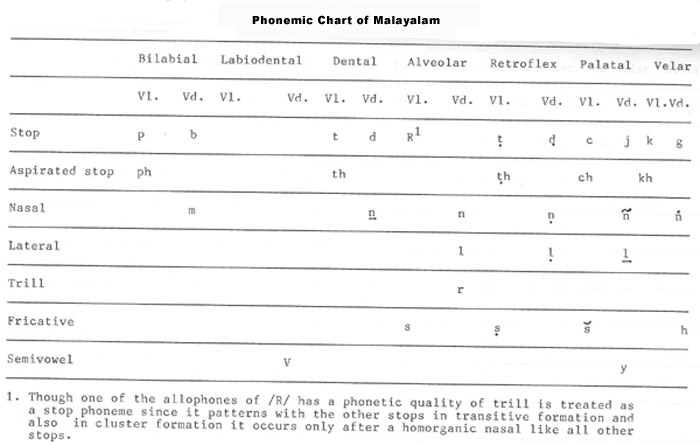
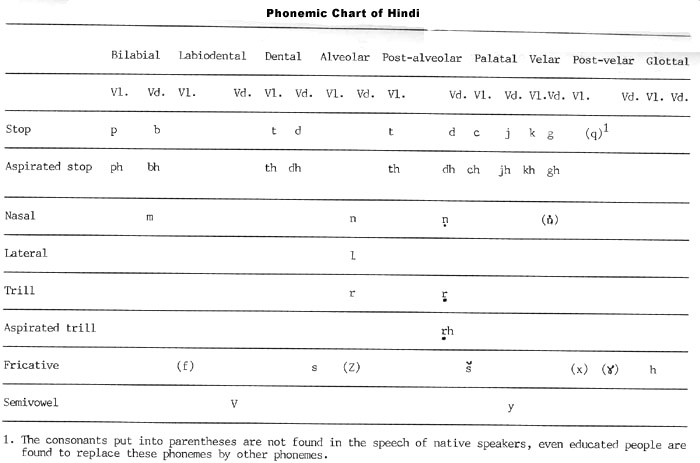
2.2 Consonants
2.2.1 Stops
2.2.1.1 Malayalam
In Malayalam there are sixteen stops. Voiced aspirated stops are absent in Malayalam [1]. All voiceless stops here have corresponding voiceless aspirated varieties also. The stops and their allophonic distribution are as follows:
1. /P/ Bilabial voiceless stop
[b, b , p]
[b] Bilabial voiced lenis fricative occurs intervocalically.
E.g. /ša:pam/ [ša:b∂˘m] ‘curse’
/ape:ksa/ [abe:ksa] ‘request’
[ b] Bilabial voiced stop with a gradual trailing in voicing occurs medially after homorganic nasal.
E.g. /tumpa/ [tumba] ‘ a plant’
/kamp>/ [kamb>] ‘stick’
[P] Bilabial voiceless fortis stop occurs elsewhere.
E.g. /patt> / [pat:>] ‘ten’
/kuppi/ [kup:i] ‘bottle’
/kopRa/ [kopRa] ‘dry coconut’
[1].The Malayalam writing system do have letters for voiced aspirated and in the writing system such words with voiced stops are written with voiced aspirated letters, however even in standard pronunciation of Malayalam the voiced aspirated are absent and hence they are not considered here as separate phonemes
2. /ph/ Bilabial voiceless aspirated stop
[ bh, bh, ph]
[bh] Bilabial semi voiced aspirated stop with a slight friction occurs intervocalically.
E.g. /a:bharaNam/ [a:bhar>n∂˘m] ‘ornament’
/vibhavam/ [vIbhav∂˘m] ‘item’
[bh] Bilabial voiced aspirated stop with a gradual trailing in voicing occurs medially after homorganic nasal.
E.g. /rembha/ [rEmbha] ‘a personal name’
/rehasyam/ [rEhasy∂˘m] ‘secret’
[ph] Bilabial voiceless aspirated stop occurs elsewhere.
E.g. /bha:sa/ [pha:sa] ‘language’
/abhram/ [aphr∂˘m]
3. /b/ Bilabial voiced stop.
[b] Bilabial voiced stop occurs initially and medially.
E.g. /jubba/ [jub:a] ‘a kind of shirt’
/balam/ [bal∂˘m] ‘strength.
4. /t/ Dental voiceless stop
[D, D, t]
[D] Dental voiced lenis fricative occurs intervocalically.
Eg. /pa:ta/ [pa:Da] ‘path’
/cata/ [caDa/ ‘flesh’
[D] Dental voiced stop with a gradual trailing in voicing occurs medially after homorganic nasal.
E.g. /cantam/ [canD∂˘m] ‘beauty’
/ventu/ [v∂nDu] ‘cooked’
[t] Dental voiceless stop occurs elsewhere.
E.g. /taTi/ [taDi] ‘wood’
/patt> / [pat:>] ‘ten’
5. /Th/ Dental voiceless aspirated stop
[Dh, Dh, th)
[Dh] Dental voiced affricate occurs intervocalically.
E.g. /redham/ [r∂Dh∂˘m] ‘chariot’
/a:dha:ram/ [a:Dha:r∂m] ‘document’
[Dh] Dental voiced aspirated stop with a gradual trailing in voicing occurs medially after homorganic nasal.
E.g. /bandhu/ [banDhu] ‘relative’
/andhan/ [anDh∂˘n] ‘blind man’
[th] Dental voiceless aspirated stop occurs elsewhere.
E.g. /dhayryam/ [thayry∂˘m] ‘courage’
/vardhiccu/ [varthIc:u] ‘increased’
6. /d/ Dental voiced stop.
[d] Dental voiced stop occurs initially and word medially with length or in clusters.
E.g. /de:ham/ [de:h∂˘m] ‘body’
/da:ridryam/ [da:rIdry∂˘m] ‘poverty’
(7) /R/ Alveolar voiceless stop.
[d , t , R]
/d/ Alveolar voiced stop occurs the homorganic nasal.
E.g. /enRe/ [ende] ‘mine’
[t] Alveolar voiceless stop occurs with length medially.
E.g. /pa:RRa/ [pa:t:a] ‘cockroach’
[R] Alveolar trill occurs elsewhere.
E.g. /kaRi/ [kaRi] ‘curry’
/Rava/ [Rava] ‘rava’
8. /T/ Retroflex voiceless stop.
[D, D, T]
[D] Retroflex voiced stop with less duration occurs intervocalically.
E.g /taTi/ [taDi] ‘wood’
/paTam/ [paD∂˘m] ‘picture’.
[D] Retroflex voiced stop with a gradual reduction in voicing occurs medially after a homorganic nasal.
E.g. /vi:NTum/ [vi:NDum] ‘again’
/paND>/ [paND>] ‘years ago’
[T] Retrofelx voiceless stop occurs elsewhere.
E.g. /paTTam/ [paT:∂˘m] ‘kite’
9. /Th/ Retroflex voiceless aspirated stop.
[Dh, Dh, Th]
/Dh / Retroflex voiced aspirated stop with a friction occurs intervocalically.
E.g. /pa:Tham/ [pa:Dh>*m] ‘lesson’
/pi:Tham/ [pi:Dh∂˘m]
[Dh] Retroflex voiced aspirated stop with a reduction in voicing occurs after the homorganic nasal.
E.g. /kaNTham/ [kaNDh∂˘m] ‘neck’
/kuNThitam/ [kunDhID∂˘m] ‘sorrow’
[Th] Retroflex voiceless aspirated stop occurs elsewhere.
E.g. /ša:Thyam/ [ša:Thy∂˘m] ‘insistence’
10. /D/ [D] Retroflex voiced stop occurs initially and medially.
E.g. /Da:ns>/ [Da:ns>] ‘dance’
11. /c/ Palatal voiceless stop.
[ j, j, c]
[j] Palatal voiced stop with a slight friction occurs intervocalically.
E.g. /vica:ram/ [vIja:r∂˘m] ‘thinking’
/paricayam/ [parIjay∂˘m] ‘familiarity’
[j] Palatal voiced stop with a gradual reduction in voicing occurs medially after the homorganic nasal.
E.g. /inci/ [inji] ‘ginger’
[c] palatal voiceless stop occurs elsewhere.
E.g. /ciri/ [cIri] ‘laugh’
/pacca/ [pac:a] ‘green’
12. /ch/ palatal voiceless aspirated stop.
[ch] palatal voiceless aspirated stop occurs word initially and medially.
E.g. /cha:ya/ [cha:ya] ‘image’
/mu:rccha/ [mu:rccha]
13. /J/ palatal voiced stop.
[J] palatal voiced stop occurs initially and medially.
E.g. /jayam/ [jay∂˘m] ‘victory’
/lejja/ [l?j:a] ‘shyness’
14. /k/ Velar voiceless stop
[G, G, k]
[G] Velar voiced stop with slight friction occurs inter-vocalically and after y and v.
E.g. /makan/ [maG∂˘n’] ‘son’
/pa:cakam/ [pa:j∂˘m] ‘cooking’
[G] Velar voiced stop with a reduction in voicing occurs medially after homorganic nasal.
E.g. /pa?k>/ [pa?G>] ‘share’
/ta?kam/ [ta?G∂˘m]
[k] Velar voiceless stop occurs and initially and medially not after nasals, y and v.
E.g. /kala/ [kala] ‘art’
/pakal/ [paG∂˘l] ‘morning’
15. /kh/ Velar voiceless aspirated stop.
[Gh, Gh, kh]
[Gh] Velar voiced aspirated stop with a fricative quality occurs intervocalically.
E.g. /sukham/ [suGh∂˘m] ‘comfort’
/nakham/ [naGh∂˘m] ‘nail’
[Gh] Velar voiced aspirated stop with a gradual reduction in voicing occurs medially after the homorganic nasal.
E.g. /ša?kh>/ [sa?Gh>] ‘xancus’
/sankham/ [sanGh∂˘m] ‘group’
[kh] Velar voiceless aspirated stop occurs elsewhere
e.g. /khani/ [khani] ‘ mine’
/mu:rkhan/ [mu:rkh∂˘n] ‘cobra’
16. /G/ Velar voiced stop
[g] velar voiced stop, occurs
(1) initially (2) medially in clusters
e.g. /guNam/ [guN∂˘m] ‘goodness’
/svargam/ [svarg∂˘m] ‘heaven’
2.2.1.2 Hindi
In Hindi there are twenty one stop consonants. Their allophonic distribution is given below:
1. /p/ Bilabial voiceless stop.
[p’ , p‘, p.’ , p]
[p’] Bilabial voiceless unreleased stop occurs finaly after a vowel and elsewhere before a consonant.
E.g. /ba:p/ [ba:p’] ‘father’
/cappal/ [c>p’pal] ‘slipper’
[p‘] Bilabial voiceless released stop occurs finally after a consonant.
E.g. />lp‘/ [ >lp‘] ‘very little’
[p.’] Bilabial voiceless unreleased relatively long stop occurs medially before /y/, /r/, /l/ and after a vowel.
E.g. /pra:py/ [p ra:p.’y] ‘attainable’
/viplav / [vIp.’L>v] ‘a riot’
/vipralambh/ [vIp.’r>l>mb] ‘deception’
[p] Bilabial voiceless stop occurs elsewhere.
E.g. /paksi/ [p>ksi] ‘bird’
/pæ:sa:/ [pæ.sa:] ‘money’
2. /ph/ Bilabial voiceless aspirated stop.
[ph‘, p.’h, ph]
[ph ] bilabial, voiceless, lightly aspirated released stop occurs word finally.
E.g. /sa:ph/ [sa:ph‘ ] ‘clean’
[p.’h] Bilabial, voiceless, lightly aspirated, unreleased, relatively long stop occurs medially before /r/ and after a vowel.
E.g. /naphret/ [n>p.’hr>t] ‘hatred’
[ph] Bilabial, voiceless, aspirated stop occurs elsewhere
e.g. /phal / [ph>l] ‘fruit’
/sapha:yi:/ [s>pha:yi:] ‘neatness’
3. /b/ Bilabial voiced stop.
[b’ , b‘, b.’ , b]
[b’] Bilabial, lightly voiced unreleased stop occurs finally after a vowel and elsewhere before a consonant.
E.g. /kab/ [k>b’] ‘when’
/bya:h/ [b’ya:h/ ‘marriage’
[b‘] Bilabial lightly voiced released stop occurs finally after a consonant.
E.g. /bimb/ [bImb‘] ‘reflection’
[b.’] Bilabial, lightly voiced, relatively long unreleased stop occurs medially before /r/ and after a vowel.
E.g. /kabr/ [k>b.’r]
[b] Bilabial, voiced, unaspirated stop occurs elsewhere.
E.g. /ba:l/ [ba:l] ‘hair’
/sabu:t/ [sabu:t] ‘evidence’
4. /bh/ Bilabial voiced aspirated stop.
[bh‘, b.’h, bh’ , bh]
[bh‘] Bilabial, voiced, lightly aspirated released stop occurs word finally.
E.g. /la:bh/ [la:bh‘] ‘profit’
/garbh/ [g>rbh‘] ‘pregnancy’
[b.’h] Bilabial, voiced, lightly aspirated relatively long unreleased stop occurs medially before /r/ or /y/ and after a vowel.
E.g. /abhyuday/ [>b.’hyuday] ‘progress’
/abhrak/ [>b.’hr>k] ‘mica’
[bh’] Bilabial, voiced, lightly aspirated unreleased stop occurs before a consonant.
E.g. /bhramar/ [bh’r>m>r] ‘bee’
/bhru:N / [bh’ru:N] ‘embryo’
[bh] Bilabial, voiced aspirated stop occurs elsewhere.
E.g. /bhi:tar/ [bhi:t>*r] ‘inside’
/bha:i:/ [bha:i:] ‘brother’
5. /t/ Dental, voiceless, stop
[t’, t‘ , t.’ , t]
[t’] Dental, voiceless, unreleased stop occurs finally after a vowel and elsewhere before a consonant.
E.g. /sa:t/ [sat’] ‘seven’
[t‘] Dental, voiceless released stop occurs finally after a consonant.
e.g. /bhakt/ [bh>k’t‘] ‘devotee’
/niyukt/ [niyuk’t‘ ] ‘appointed’
[t.’] Dental voiceless, relatively long unreleased stop occurs medially before /y/, /r/, /v/ and after a vowel.
E.g. /satya: grah/ [s>t.’ya:gr>h] ‘resistance’
/patrika/ [p>t.’rika] ‘magazine’
[t] Dental voiceless, stop occurs elsewhere.
E.g. /talva:r/ [t>lva:r] ‘sword’
/antar/ [>nt>r] ‘difference’
6. /th/ Dental, voiceless aspirated stop.
[th‘, t.’h, th’, th]
[th‘] dental, voiceless, lightly aspirated released stop occurs word finally.
E.g. /sa:th/ [sa:th‘/ ‘along with’
/arth/ [>rth‘/ ‘meaning’
[t.’h] Dental, voiceless, lightly aspirated relatively long unreleased stop. Occurs medially before /v/ and /y/ and after a vowel.
E.g. /prithvi/ [prit.’hwi:] ‘earth’
[th’] dental voiceless aspirated unreleased stop occurs before a consonant.
e.g. /tverit/ [th‘w>rIt] ‘sudden’
[th’] dental voiceless aspirated stop occurs elsewhere.
e.g. /patthar/ [p>t’th’>r] ‘stone’
7./d/ dental, voiced stop
[d’ , d‘, d.’ , d]
/d’/ dental voiced unreleased stop occurs finally after a vowel and elsewhere before a consonant.
E.g. /visa:d/ [vIsa:d’] ‘sadness’
[d‘] dental slightly voiced released stop occur after a consonant.
E.g. /d>rd‘/ [d>rd‘] ‘pain’
[d.]Dental voiceless relatively long unreleased stop occurs medially before /r/, /v/, /y/ and after a vowel.
E.g. /vidro:h/ [vId.’ro:h]
/vidva:n/ [vId.’wa:n]
/pady/ [pad.’y] ‘poetry’
[d] Dental voiced unreleased stop occurs elsewhere.
E.g. /da:n/ [da:n]
/andar/ [>nd>r]
8. /dh/ Dental voiced aspirted stop.
[dh‘, d.’h, dh’ , dh]
[dh‘] dental, voiced, lightly aspirated released stop occurs word finally.
E.g. /ardh/ [>rdh‘] ‘meaning’
/sa:dh/ [sa:dh‘] ‘together’
[dh’] dental, voiced aspirated unreleased stop occurs before a consonant.
E.g. /dh’vaj/ [dh’w>j‘] ‘flag’
/dhruv/ [dh’ruv‘ ] ‘north pole’
[d.’h] dental, voiced, lightly aspirated relatively long unreleased stop occurs medially before /v/, /r/, /y/ and after a vowel.
E.g. /vidhvms/ [vId.’hw> ms] ‘destruction’
/adhya:y/ [>d.’hya:y] ‘chapter’
[dh] dental, voiced aspirated stop occurs elsewhere.
E.g. /dh>n‘ / [dh>n‘] ‘wealth’
/andh/ [>n’dh‘] ‘blind’
9. /T/ post-alveolar, voiceless stop.
[T’, T‘, T.’ , T ]
[T’] post-alveolar, voiceless unreleased stop occurs finally after a vowel and elsewhere before a consonant.
E.g. /miTTi/ [mIT’Ti] ‘earth’
/ka:T/ [ka:T’] ‘mattress’
[T‘] post-alveolar, voiceless, released stop occurs finally after a consonant.
E.g. /paTT/ [p>T’T‘] ‘a document’
[T.’] post-alveolar, voiceless, relatively long unreleased stop occurs medially before /y/ and after a vowel.
E.g. /ek>Ty/ [ek>T.’y] ‘unity’
[T]post-alveolar, voiceless stop occurs elsewhere.
e.g. /T>p/ [T>p’] ‘cover’
(10) /Th/ post-alveolar, voiceless, aspirated stop.
[Th‘, Th]
[Th‘] post-alveolar, voiceless, lightly aspirated released stop occurs word finally.
E.g. /a:Th / [a:Th‘] ‘eight’
/kaNTh/ [k>NTh‘] ‘neck’
[Th] post-alveolar, voiceless, aspirated stop occurs elsewhere.
E.g. /Tho:kar/ [Tho:k>r] ‘blow’
/kaThin/ [k>ThIn‘] ‘difficult’
11. /D/ post-alveolar, lightly voiced stop.
[D’ , D‘ , D.’, D]
[D’] post-alveolar, lightly voiced, unreleased stop occurs finally after a vowel or before a consonant.
E.g. /leD/ [leD’] ‘mortar plaster’
/haDDi:/ [h>D’Di:] ‘bone’
[D‘] post-alveolar, lightly voiced, relatively long unreleased stop occurs medially before /y/ and after a vowel.
E.g. /ja:Dy/ [ja:D’y] ‘stupidity’
[D] post-alveolar, voiced stop occurs elsewhere.
E.g. /Da:li:/ [Da:li:] ‘branch’
/Dibba:/ [Dib’ba:] ‘compartment’
12. /Dh/ post-alveolar voiced stop.
[Dh‘ , D.’h, Dh]
[Dh‘] post-alveolar, voiced lightly aspirated released stop occurs word finally.
E.g. /dhu:NDh/ [Dhu:Dh] ‘investigation’
[D.’h] post-alveolar, voiced, lightly aspirated unreleased stop occurs medially before /y/ and after a vowel.
E.g. /a:Dhy/ [a:d.’hy’] ‘rich’
[Dh] post-alveolar, voiced aspirated stop occurs elsewhere.
/Dha:l/ [Dha:l’] ‘a shield’
/aDhak/ [>Dh> k’] ‘hurt’
13. /c/ palatal voiceless stop
[c’, c‘, c.’, c]
[c’] palatal voiceless unreleased stop occurs finally after a vowel and elsewhere before a consonant.
E.g. /sac/ [s>c’] ‘truth’
/bacpan/ [b>c’pan’] ‘childhood’
[c‘] palatal voiceless released stop with slight friction occurs finally after a consonant.
e.g. /mirc/ [mirc‘]
/kharc/ [kh>rc‘] 'expense'
[c. '] palatal voiceless unreleased, relatively long stop occurs medially before /y/ and after a vowel.
e.g. /acyut/ [ ac.’Ut'] ‘eternal’
[c] palatal, voiceless, unreleased stop with slight friction occurs elsewhere.
e.g. /ca:ca:/ [ca:ca:] 'paternal uncle'
/vica:r/ [vIca:r] 'thought'
14. /ch/ palatal, voiceless, aspirated stop.
[ch‘, ch’, c.’h, ch]
[ch‘] palatal voiceless, lightly, aspirated stop released with a friction occurs word finally.
E.g. /svech/ /sw>c’ch‘] ‘calm’
[ch’] palatal, voiceless, lightly aspirated unreleased stop occurs before a consonant.
[c’.h] palatal, voiceless, aspirated, relatively long, unreleased stop occurs medially before /v/ and after a vowel.
E.g. [uc.’hwa:s]
[ch] palatal, voiceless, aspirated stop released with friction occurs elsewhere.
E.g. /accha:/ [ac’cha:] ‘good’
/cha:ya:/ [cha:ya] ‘reflection’
15. /J/ palatal, voiced stop
[j’, j‘, j.’, j]
[j’] palatal, voiced, unreleased stop occurs finally after a vowel, elsewhere before consonant.
E.g. /bi:j/ [bi:j’] ‘a seed’
[J‘] palatal, voiced, released stop with slight friction occurs finally after a consonant.
E.g. /hajj/ [h>j’j] ‘hajj’
[j.’] palatal, voiced, unreleased relatively long stop occurs medially before /r/, /v/, /y/ and after a vowel.
E.g. /vajr/ [v>j’r] ‘diamond’
/ujjval/ [uj.’jval]
/ra:jy/ [ra:j.’y]
[j] palatal, voiced stop, released with a friction occurs elsewhere.
e.g. /ja:ti/ [ja:ti]
16. /Jh/ palatal, voiced, aspirated stop
[jh‘ , jh]
[jh‘ ] palatal voiced lightly aspirated stop released with friction occurs finally.
E.g. /sa:jh/ [sa:jh‘]
[jh ] palatal, voiced asirated stop released with friction occurs elsewhere.
E.g. /jha:g/ [jha:g]
17. /k/ velar, voiceless stop
[k’, k‘ , k.’, k]
[k’] velar, voiceless, unreleased stop occurs finally after a vowel. Elsewhere before a consonant.
E.g. /Da:k/ [da:k’ ] ‘a stage-coach’
/aksar/ [> k’s>r]
[k‘] velar, voiceless, released stop occurs finally before a consonant.
E.g. /tark/ [t >rk‘]
[k.’] velar, voiceless, unreleased, relatively long top occurs medially after /l/, /r/, /v/, /y/ and before a vowel.
E.g. /takli:f/ [t>k.’li:f]
/atikram/ [>tik.’R>m]
/pavk/ [p>k.’w]
/æ:kyata/ [æ:k.’yata’] ‘unity’
[k] velar, voiceless stop occurs elsewhere.
E.g. /katha:/ [k>tha:] ‘story’
/taka:n/ [taka:n] ‘gaze’
18. /kh/ velar, voiceless, aspirated stop.
[kh‘, kh’, k.’h, kh]
[kh‘ ] velar, voiceless, lightly aspirated released stop occurs word finally.
E.g. /a:nkh/ [a:kh‘] ‘eye’
/mu:rkh/ [mu:rkh] ‘foolish’
[kh’] velar, voiceless, lightly aspirated stop occurs before a consonant.
E.g. /khya:ti:/ [kh’ya:ti:] ‘fame’
[k.’h] velar, voiceless, lightly aspirated, unreleased relatively long stop occurs medially before /y/ and after a vowel.
e.g. /vikhaya:t/ [vIk.’hya:t’]
[kh] velar, voiceless, aspirated stop occurs elsewhere.
E.g. /khani/ [kh>ni:] ‘mine’
/sa:kha:/ [sa:kha:] ‘branch’
19. /g/ velar voiced stop
[g’, g‘, g.’, g]
[g’] velar, voiced, unreleased stop occurs finally after a vowel, elsewhere before a consonant.
E.g. /a:g/ [a:g’] ‘fire’
[g‘] velar, voiced released stop occurs finally after a consonant.
E.g. /ma:rg/ [ma:rg‘] ‘way’
[g.’] velar, voiced, unreleased, relatively long stop occurs, medially before r/, /y/ and after a vowel.
E.g. /agr/ [ag.’r] ‘tip’
[g] velar, voiced stop occurs elsewhere.
E.g. /gati/ [g>ti]
20. /gh/ velar, voiced aspirated stop.
[gh’, gh‘ , g.’h, gh]
[gh’] velar, voiced, lightly aspirated released stop occurs word finally.
E.g. /sangh/ [sangh]
[gh’] velar, voiced, lightly aspirated unreleased stop occurs before a consonant.
e.g. /ghra:N/ [gh’ra:N] ‘odor’
[g.’h] velar, voiced, lightly aspirated, relatively long stop occurs medially before /r/, /y/ and after a vowel.
E.g. /si:ghr/ [si:g.’hr]
[gh] velar voiced aspirated stop occurs elsewhere.
e.g. /ghaDi/ [gh>Di:] ‘time’
2.2.1.3 Similarities and dissimilarities
The stop consonants /p, ph, b, t, th, d, c, ch, j, k, kh, g/ are similar in both Malayalam and Hindi. e.g.
Malayalam Hindi
/paksi/ [paksi/ ‘bird’ /paksi:/ [p>ksi:] ‘bird’
/pha:n/ [pha:n/ ‘fan’ /phal/ [ph? l] ‘fruit’
/balam/ [bal>*m/ ‘strength’ /ba:l/ [ba:l] ‘hair’
/taTi/ [taDi] ‘wood’ /tatv/ [t>tv] ‘principle’
/thayram/ [thayry>*m] ‘courage’ /thakka:/ [th>k’ka:] ‘a clot’
/de:ham/ [de:h>*m] ‘body’ /da:n/ [da:n] ‘charity’
/ca:ya/ [ca:ya] ‘tea’ /ca:ca/ [ca:ca/ ‘paternal uncle’
/cha:ya/ [cha:ya] ‘reflection’ /cha:ya:/ [cha:ya:] ‘reflection’
/jayam/ [jay>*m] ‘victory’ /jan/ [j>n’] ‘ people’
/katha/ [k>tha:] ‘story’ /katha:/ [k>tha:] ‘story’
/khani/ [khani] ‘mine’ /khani/ [khani:] ‘mine’
/guNam/ [guN>*m] ‘merit’ /guN/ [guN] ‘merit’
In Malayalam voiced aspirated stops are found only in the allophonic level. The allophones [bh] of the phoneme /ph/ and [dh] of the phoneme /th/ are voiced aspirated in Malayalam. Thus these phonemes are partially similar to Hindi phonemes /bh/ and /dh/ in the allophonic level.
E.g.
/rempha/ [r?mbha] ‘a prl..name’ /la:bh/ [la:bh] ‘profit’
/banthu/ [banDhu] ‘relative’ /ardh‘ / [ardh‘] ‘meaning’
The Malayalam phonemes / T, Th, D/ are partially similar to Hindi /T, Th, D/. In Malayalam these sounds are retroflex stops. In Hindi they are post alveolar stops with a very little retroflexion.
E.g.
M H
/Tin/ [Tin] ‘Tin’ /Tap’/ [T>p’] ‘cover’
/ša:Thyam/ [ša:thy?m] ‘insistence’ /kaThin/ [k>Thin] ‘difficult’
/Da:ns>/ [da:ns >] ‘dance’ /Da:li:/ [Da:li] ‘branch’
The alveolar voiceless stop /R/ of Malayalam has no equivalence in Hindi.
The stops /Dh, jh, gh, q /are found in Hindi only. Of these the phoneme / q / very rarely occurs in Hindi and is found only in words of Persian origin.
2.2.2 Nasals
2.2.2.1 Malayalam
In Malayalam there are six nasals. The allophonic distribution of these six nasals are given below.
[m, m]
[m] Labio dental nasal occur medially before V.
E.g. /samvarnam/ [samvar>*N>*m] ‘reservation’
[m] Bilabial nasal occurs initially, medially and finally
e.g. /masi/ [masi] ‘ink’
/umi/ [umi] ‘paddy husk’
/maram/ [mar>?m] ‘tree’
2. /n/ Dental nasal occurs initially independently and medially in clusters.
E.q. /inn / [inn>] ‘today’
/nayam/ [nay> ?m] ‘policy’
/nruttam/ [nrwt:>?m’] ‘dance
/cantam/ [cant> ?m] ‘beauty’
3. /n/ Alveolar nasal
[n] Alveolar nasal occurs initially before [y], medially and finally.
E.g. /nya:yam/ [nya:y>?m] ‘justice’
/vinayam/ [vinay>? m] ‘obedience’
/mi:n/ [[mi:n] ‘fish’
4. /N/ Retroflex nasal.
[N] Retroflex nasal occurs medially and finally.
e.g. /paNam/ [paN>? m] ‘money’
/ju:N/ [ju:N] ‘June’
5. /ň/ palatal nasal
[ň] palatal nasal occurs initially and medially.
E.g. /ňa:n/ [ňa:n] ‘I’
/maňň>/ [maňň>] ‘dew’
6. /ŋ/ velar nasal.
[ŋ] velar nasal occurs medially with length or in clusters.
E.g. /ma:ŋŋa/ [ma:ŋ:a] ‘mango’
/taŋŋi/ [taŋ:i] ‘stayed’
2.2.2.2 Hindi
There are four nasal consonants in Hindi. Their occurrence and allophonic distributions are given below.
1. /m/ Bilabial, voiced nasal stop.
[m’ , m‘, m.’ , n]
[m’] bilabial, voiced, orally unreleased nasal finally after a vowel, elsewhere before consonant.
e.g. /na:m/ [na:m’] ‘name’
/ambar/ [am’b>r ] ’sky’
[m‘] bilabial , voiced orally released nasal occurs finally after a consonant.
e.g /khatm/ [kh>tm‘]
[m.’] bilabial, voiced , orally unreleased, relatively long nasal occurs medially before /l/, /r/, /y/ and after a vowel.
e.g. /hamla:/ [h>m.’la:]
/s>mra:T/ [s>m.’ra:T]
[m] Bilabial, voiced nasal stop occurs elsewhere.
E.g. /ma:la:/ [ma:la:] `garland’
/kama:1/ [k>ma:l‘]
2. /n’, n`, n.’ N]
[n’] Alveolar, voiced, orally unreleased nasal occurs finally after a vowel or elsewhere before a consonant.
e.g. /ma:n/ [ma:n’]
[n‘] Alveolar, voiced, orally realased nasal occurs finally after a consonant.
E.g: /vikhn/ [vikhn‘]
[n.’] Alveolar, voiced, orally unreleased relatively long nasal occurs medially before /v/, /y/ and after a vowel.
Eg. /anya:y/ [an.’ya:y] ‘injustice’
[n] Alveolar, voiced nasal occurs elsewhere
eg: /na:k/ [na:k’] ‘nose’
/vinay/ [vInay]
/N/ post-alveolar, voiced , flap nasal.
[N’ , N.’ , N]
[N’] post-alveolar, voiced, orally released nasal occurs medially before a post - alveolar stop.
Eg. /caNT/ [c>N’T’]
[N.’] post alveolar, voiced orally unreleased relatively long, nasal consonant occurs medially before /y, /V/ and after a vowel.
Eg: /araNy/ [>raN.’y] `forest’
[N] post-alveolar, voiced, orally unreleased relatively long, nasal occurs intervocalically and finally.
Eg. /gaNe:š/ [g >Ne:š]
/gaN/ [g>N’]
(4). /ň/ [ň] palatal, voiced, orally unreleased nasal occurs medially before palatal consonants.
Eg: /paňci:/ [paňchi:] `bird’
[ŋ] velar, voiced, unreleased nasal occurs finally after a vowel, medially before a consonant.
Eg: /raŋg/ [r>ŋg] `colour’
/uŋgali/ [uŋli:] `finger’
2.2.2.3. Similarities and dissimilarities
The nasals /m, n, ŋ/ are similar in both Malayalam and Hindi .
eg:
M. H
/ma:la/ [ma: la] `garland’ /ma:la:/ [ma:la:] `garland’
/nya :yam/ [nya:.y>*m] `justice’ /nya:y/ [nya:y’] `justice’
/rangam/ [raŋg>*m] ‘ part’ /raŋg:/ [raŋg`] `colour’
The nasals /N,ň/ in Malayalam are partially similar to Hindi sounds /N, ŋ/ . / N / is retroflex nasal in Malayalam whereas in Hindi the /N/ is post alveolar nasal with a flap quality. Eg:
M H
/guNam/ [guN>* m] `merit’ /gaN/ [g>N] `group’
/n/ in Malayalam is partially similar to Hindi /n/ because the similarity is in the allophonic level. One of the allophones of the Hindi phoneme /n/ is the palatal voiced stop [n] thus it shows similarity with Malayalam /n/.Eg:
M H
/anc>/ [anc>] `five’ /p>nchi:/ [p>nchi:] `bird’
The dental voiced nasal phoneme /n/ in Malayalam has no equivalence in Hindi.
2.2.3. Laterals
2.2.3.1 Malayalam
In Malayalam there are three laterals. Their allophones and distribution are given below:
1. /l/ Alveolar lateral occurs initially, medially and finally.
eg: /la:bham/ [la:bh>* m] `profit’
/ka:lam/ [ka:l>* m] `season’
/kaTal/ [kaD >*l] `sea’
2. /L/ Retroflex lateral occurs medially and finally.
Eg: /vaLa/ [vaLa] `bangle’
/avaL/ [avaL] `she’
3. /ļ/ palatal lateral
[ļ] prepalatal retroflex lateral with slight friction occurs medially.
Eg: /kaļiv>/ [kaļiv>] `ability’
2.2.3.2. Hindi
In Hindi there is only one lateral /1/. Its allophones and their distribution are as follows:
e.g.: /1/ Alveolar voiced lateral consonant.
[1’ , 1‘, 1.’ , 1]
[1’] Alveolar voiced unreleased lateral occurs finally after a vowel or before a consonant.
Eg: /pal/ [pal’] `moment’
/ulTi/ [ul’Ti:] `inverted’
[1‘] Dental voiced released lateral occurs finally after a consonant.
Eg: /šukl‘/ [šukl‘] `white’
[1.’] Alveolar voiced relatively long, unreleased lateral occur medially before /y/ and after a vowel.
Eg: /kalya:N/ [k>l.’ya:N]
[1] Alveolar voiced lateral occurs elsewhere.
Eg: /lo:g/ [lo:g’] `people’
/kala:/ [kala:] `art’
2.2.3.3. Similarities and dissimilarities
The alveolar lateral /1/ is similar in both Malayalam and Hindi.
Eg:
M H
/la:pham/ [la:bh>* m] `profit’ /la:bh/ /la:bh’] `profit’
The retroflex voiced lateral /L/ and the palatal voiced lateral /ļ / in Malayalam have no equivalence in Hindi.
2.2.4 Trills
2.2.4.1 Malayalam
In Malayalam there is only one trill /r/.
/r/ Alveolar trill
[r] Alveolar flap with slight trilling occurs initially and medially.
E.g. /kari/ [kari] ‘charcoal’
/ripu/ [rI bu] ‘enemy’
2.2.4.2 Hindi
The trill consonants present in Hindi are /r, R, Rh/.
1. /r/ Alveolar voiced trilled consonant.
[r, , ]
[r] Alveolar voiced trilled consonant occurs medially after a consonant.
E.g. /kram/ [kram] ‘order’
/namrata:/ [namrata:]
[ l ] Alveolar voiced fricative occurs initially and finally.
E.g. /ra:t/ [la:t’ ] ‘night’
/ca:r/ [ca: l] ‘four’
[ ] Alveolar voiced flapped occurs intervocalically
e.g. /co:ri/ [co: I:] ‘theft’
2. /r/ post alveolar retroflex flap occurs medially and finally.
E.g. /pe:T/ [pe: r] ‘tree’
/paTa:/ [p> ra:] ‘laid’
3. /rh/ post alveolar voiced lightly aspirated retroflex flap.
[rh] post-alveolar voice lightly aspirated retroflex flap occurs medially and finally.
E.g. /paTh/ [parh]
/paTha:/ [p> rha:]
2.2.4.3. Similarities and dissimilarities
Alveolar voiced trill /r/ of Malayalam is partially similar to Hindi /r/ because one of the allophones of Hindi /r/ shows similarity.
e.g. M H
/co:ra/ [co:ra] ‘blood’ /co:ri/ [co: i:] ‘theft’
The post-alveolar voiced trills / r , rh / of Hindi have no equivalence in Malayalam. However, one of the allophones of the alveolar voiceless stop /R/ of Malayalam i.e., [R] has similarity with Hindi alveolar trill.
2.2.5 Fricatives
2.2.5.1 Malayalam
The four fricatives of Malayalam and their allphonic distribution are shown below:
1. /s/ Alveolar voiceless fricative
[s] Alveolar voiceless fricative occurs initially and medially.
E.g. /samam/ [sam>* m] ‘equal’
/vista:ram [vIsta:r>* m] ‘area’
2. /ş / Retroflex voiceless fricative.
[ş] Retroflex voiceless fricative occurs initially and medially.
E.g. /şaNmukham/ [şaNmukh>*m] ‘a prl. name’
/vişam/ [ vIş>*m] ‘poison’
/kaşTam/ [kaşT>*m]
3. / š / palatal voiceless fricative.
[ š] palatal voiceless fricative occurs initially and medially.
E.g /šakti/ [šakti] ‘strength’
/vašam/ [vaš>*m] ‘side’
/višvam/ [vIšv>*m] ‘world’
4. /h/ velar voiceless fricative
[x , h]
[x] Velar voiceless fricative occurs medially after nasals.
E.g. /sihman/ [sImx>*m] ‘lion’
[h] Velar voiceless fricative occurs initially and medially.
E.g. /ha:ram/ [ha:r >*m] ‘garland’
/de:ham/ [de:h>*m] ‘body’
2.2.5.2 Hindi
1. /f / [f] voiceless labio-dental fricative occurs in all positions.
Eg: /fu:l’/ [fu:l’] `flower’
2. / s / Alveolar voiceless, relatively long fricative occurs medially before /1/, /r/, /v/, /y/ and after a vowel.
Eg: /rahasy/ [r>h>s.y ‘] `secret’
[s] Alveolar voiceless fricative occurs elsewhere.
E.g. /samay/ [s>m> y’] `time’
3./ š / Palatal voiceless fricative.
[š. , š ]
[š.] palatal voiceless relatively long grooved fricative occurs medially before /l/, /r/, /v/, /y/ and after a vowel.
e.g. /višra:m/ [vIš.ra:m]
/višva:s/ [vIšwa:s]
[š ] palatal, voiceless grooved fricative occurs elsewhere.
e.g. /šo:r/ [šo:r]
/nakša:/ [n>kša:]
4. /z/ [z] pre-palatal voiced fricative occurs in all positions.
Eg: /zya:da: / [zya:da:] `more’
/ra:z/ [ra:z]
5. /h/ glottal frictionless continuant [ h, h ]
[h] Glottal frictionless occurs finally.
Eg. ./ra:h/ [ra:h]
[ h ] Glottal frictionless continuant occurs finally.
Eg: /kahta:/ (k>hta:]
2.2.5.3. Similarities and dissimilarities
The fricatives /s/ and /š / are similar in both Malayalam and Hindi.
Eg:
M H
/samayam/ [samay>* m] `time’ /sam/ [sam’] `equal’
/višva:sam/ [vIšva:s>*m] `faith’ /vIšwa:s/ [višwa:s‘] `faith’
Fricative /s/ is present only in Malayalam /h/ in Malayalam is voiced velar fricative whereas that in Hindi is voiced glottal fricative.
The fricatives /f, z, x, r/ have no equivalents in Malayalam
The sound / f / is present in Malayalam but it is restricted to a few English words borrowed to Malayalam and that too amongst the educated people and hence not considered as a separate phoneme in Malayalam.
2.2.6 Semivowels
2.2.6.1 Malayalam
The two semivowels of Malayalam are /v, y/. Their allophonic distribution is as follows:
1. /v/ Labio-dental voiced continuant.
[v] Labio-dental voiced continuant occurs initially and medially.
E.g. /vara/ [vara] ‘line’
/avan/ [av>*n] ‘he’
2. /y/ [y] palatal voiced continuant occurs initially medially and finally.
E.g. /ya:tra/ [ya:tra] ‘journey’
/viyarapp>/ [vIyarp:>] ‘sweat’
/va:y/ [va:y] ‘mouth’
2.2.6.2. Hindi
The two semivowels of Hindi are /v, y /.
1. /v/ labio-dental voiced frictionless continuant.
[ w, U, v. , v ]
[w] Bilabial voiced frictionless continuant occurs medially after a consonant.
e.g... /svi:ka:r/ [swi:ka:r]
/ašv/ [ >šw]
[U] Devoiced, Back, Short, non-syllabic vowel occurs finally after a vowel.
E.g. /bha:v/ [bha:U/
[V.] labio-dental voiced, frictionless continuant occurs elsewhere.
E.g. /a:va:z/ [a:va:z] ‘noise’
2. /Y/ palatal voiced frictionless continuant.
[y] Palatal voiced, frictionless continuant occurs everywhere.
E.g. /ya:tri:/ [ya:t’ri:]
2.2.6.3 Similarities and dissimilarities
The two semivowels /v, y/ are similar in both Malayalam and Hindi.
e.g.
M H
/ya:tra/ [ya:tra] ‘journey’ /ya:tri:/ [ya:tri] ‘traveller’
/vara/ [vara] ‘line’ /vastu/ [v>st u / ‘thing’
2.3. Clusters
In both Malayalam and Hindi consonant clusters are found in the initial and medial positions. Word final clusters are found only in Hindi. Vowel clusters are found only in Hindi. In Hindi vowel clusters are found in the word initial, medial and final positions. These vowel clusters in pronunciation may be replaced with y or v, but in standard writing system they are retained as sequence of vowels only. In Malayalam clustering of vowels does not exist.
2.3.0. Consonant Clusters
2.3.1 Initial Clusters
2.3.1.1 Malayalam
pL - /pLa:v / ‘Jack fruit tree’
pL - /pLa:stic/ ‘plastic’
pr - /pra:vu/ ‘Dove’
bl - /blavsu/ ‘blouse’
br - /bra:hmanan/ ‘Brahmin’
bhr - /bhara:nt > / ‘madness’
tr - /tripura/ ‘Tripura’
tv - /tvak:> / ‘skin’
ty - /tya:gam/ ‘sacrifice’
dr - /drutagati/ ‘in a speedy manner’
dv - /ddve:sam/ ‘hatred’
dy - /dyuti/ ‘brightness’
dhv - /dhavamsanam/ ‘suppression’
dhy - /dhya:nam/ ‘meditation’
jn - /jna:nam/ ‘knowledge’
jv - /jva:la/ ‘flame’
jy - /jyo:ti/ ‘brightness’
kl - /kle:sanm/ ‘difficulty’
kr - /kru:ram/ ‘horrible’
ks - /se:tram/ ‘temple’
ky - /kya:mp> / ‘camp’
khy - /kya:ti/ ‘ fame’
gL - /gLa:s> / ‘glass’
gr - /ga<mam/ ‘village’
ghr - /ghara:Nam/ ‘smell’
mL - /mLa:nata/ ‘silence’
sp - /sparsam/ ‘touch’
sph - /sphuraNam/ ‘sparking’
st - /sthalam/ ‘stoppage’
sth - /sthalam/ ‘place’
sk - /sku:L/ ‘school’
skh - /skhalanam/ ‘stumbling’
sm - /sma:rakam/ ‘memorial’
sn - /sneham/ ‘affection’
sL - /sLe:r:>/ ‘slate’
sr - /sra:v> / ‘a fish’
sv - /svabha:vam/ ‘character’
šm - /šmaša:nam/ ‘funeral place’
šL - /šLo:kam/ ‘poetry’
šr - /šrad:ha/ ‘attention’
šv - /šva:sam/ ‘breath’
šy - /šya:mala/ ‘prl.name(f)’
hr - /hrasvam/ ‘short’
vr - /vratam/ ‘fasting’
vy - vyakti/ ‘person’
Three consonant clusters
str - /stri:/ ‘woman’
2.3.1.2 Hindi
pr - /prave:š/ ‘entrance’
py - /pya:R/ ‘affection’
br - /bra:hmin/ ‘Brahmin’
by - /bya:j/ ‘marriage’
bhr - /bhra:ta:/ ‘brother’
tr - /tra:s/ ‘terror’
tv - /tvara:/ ‘Speed’
dr - /drav/ ‘liquid’
dv - /dva:R/ ‘gate’
dy - /dyuti/ ‘brightness’
dhy - /dhya:n/ ‘meditation’
dhv - /dhvani/ ‘sound’
jv - /jva:la:/ ‘flame’
jy - /jo:ti/ ‘light’
kr - /kriya/ ‘action’
kl - /kle:d/ ‘moisture’
kv - /kva:ra:/ ‘unmarried’
ks - /ksan/ ‘moment’
ky - /kya:ri/ ‘flowerbed’
khy - /kya:t/ ‘famous’
gr - /gra:m/ ‘village’
gv - /gva:la:/ ‘cow-keeper’
gy - /gya:n/ ‘knowledge’
ml - /mla:n/ ‘faded’
ny - /nya:y/ ‘justice’
sp - /sparš/ ‘touch’
sph - /spho:t/ ‘explosion’
st - /stambh/ ‘pillar’
sk - /skand/ ‘destruction’
skh - /skhalan/ ‘stumbling’
sm - /smaran/ ‘memory’
sn - /sna:n/ ‘bathing’
šr - /šro:t:/ ‘hearer’
sv - /svabha:v/ ‘nature’
sy - /sya:hi/ ‘ink’
zy - /zya:da/ ‘more’
šr - /šro:Ta:/ ‘hearer’
šl - /šlo:k/ ‘Sanskrit couplet’
šy - /šya:m/ ‘black’
hr - /hrasv/ ‘short’
vr - /vrat/ ‘fasting’
vy - /vya:pa:r/ ‘business’
vy - /vya:pa:r/ ‘business’
Three consonant clusters
str - /stri:/ ‘woman’
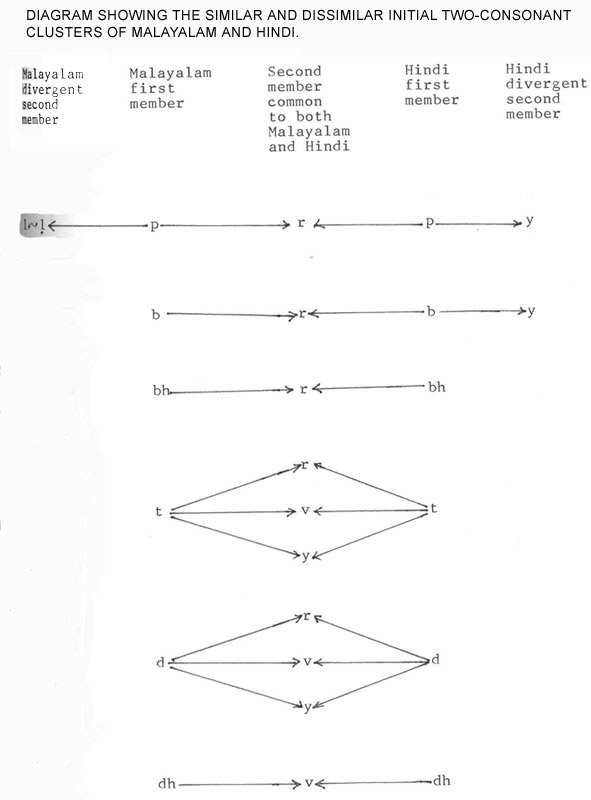
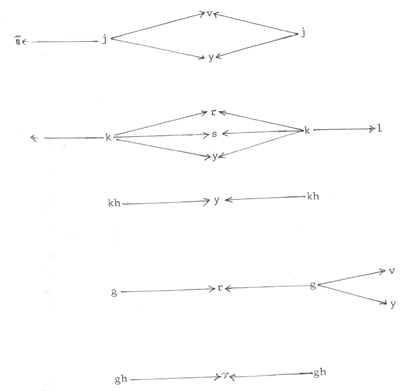

2.3.1.3 Similarities and Dissimilarities
Initial consonant clusters are found both in Malayalam and Hindi. The presence of initial consonant clusters is limited when compared to the medial clusters. The predominant pattern of initial consonant cluster is C1 C2 in both the languages. In the initial position C1 C2 C3 type is also found in both Malayalam and Hindi but its number is very limited.
The major patterns found in the initial two consonant clusters are stop + trill, stop + lateral, nasal + semivowel, fricative + stop, fricative + nasal, fricative + lateral, fricative + trill, fricative + semivowel, semivowel + trill, semi-vowel + semivowel in both Malayalam and Hindi.
Thus in the initial position when stop is the first member, the second member can be trill, lateral, fricative or semivowel and when fricative is the first constituent stop, nasal, lateral, trill, fricative or semivowel can occur as the second constituent in both the languages. When semivowel occurs as the first constituent the second consonant may be a trill or a semivowel.
Word initial two-consonant clusters
In the word initial two-consonant clusters eighteen clusters are found similar in both Malayalam and Hindi with stop as first constituent. They are:
Malayalam Hindi
pr - /pra:v> / ‘Dove’ pr - /prave:š / ‘entrance’
br - /bra:hmaNan/ ‘Brahmin’ br - /bra:hmin/ ‘Brahmin’
tr - /tra:s>/ ‘common balance’ tr- /tra:s/ ‘terror’
tv- /tvakk>/ ‘skin’ tv- /tvara:/ ‘speed’
ty- /tya:tgam/ ‘sacrifice’ ty- /tya:g/ ‘resignation’
dr- /drutagati/ ‘in a speedy manner’ dr- /drav/ ‘liquid’
dv- /dve:sam/ ‘hatred’ dv- /dva:r/ ‘gate’
dy- /dyuti/ ‘brightness’ dy- /dyuti/ ‘brightness’
dhy- /dhya:nam/ ‘meditation’ dhy- /dhya:n / ‘meditation’
jv- /jva:la/ ‘flame’ jv- /jva:la:/ ‘flame’
jy- /jyo:ti/ ‘light’ jy- /jyo:ti:/ ‘light’
kr- /kriya/ ‘action’ kr- /kru:r/ ‘cruel’
ks- /kse:tram/ ‘temple’ ks- /ksaN/ ‘moment’
ky- /kya:mp>/ ‘camp’ ky- /kya:ri:/ ‘flower bed’
khy- /khya:ti/ ‘fame’ khy- /khya:t/ ‘famous’
gr- /gra:mam/ ‘village’ gr- /gra:m/ ‘village’
ghr- /ghra:Nam/ ‘smell’ ghr- /ghra:N/ ‘smell’
In the initial two-consonant clusters with stop as first constituent certain types of clusters are restricted to only one language. Those types are listed below:
Clusters found only in Malayalam are:
PL- /pLa:v>/ ‘jack fruit tree’
jn- /jna:nam/ ‘knowledge’
kL- /kLe:šam/ ‘difficulty’
Clusters found only in Hindi are:
py- / pya:r/ ‘affection’
by- /bya:j/ ‘marriage’
kl- /kle:D/ ‘moisture’
kv- /kva:ra/ ‘unmarried’
gv- /gva:la/ ‘cow-keeper’
gy- /gya:n/ ‘knowledge’
In the word initial position with Nasal as first constituent, two types of clusters are found in both Malayalam and Hindi. They are similar in both the languages.
Malayalam Hindi
mL - /mlanada/ ‘silence’ ml - /mla:n/ ‘faded’
ny - /nya:yam/ ‘justice’ ny - /nya:y/ ‘justice’
With fricative as first constituent, fifteen clusters are found to be similar in both the languages. They are:
Malayalam Hindi
sp - /sparšam/ ‘touch’ sp - /sparš/ ‘touch’
sph - /spho:Tanam/ ‘explosion’ sph - /sphoT/ ‘explosion’
st - /stambhanam/ ‘stoppage’ st - /stambh/ ‘pillar’
sth - /sthalam / ‘place’ sth - /sthal/ ‘place’
sk- /sku:L/ ‘school’ sk - /skand/ ‘destruction’
skh- /skhalanam/ ‘stumbling’ skh- /skhalanm/ ‘stumbling’
sm- /sma:rakam/ ‘memorial’ sm- /smaran/ ‘memory’
sn- /sne:ham/ ‘affection’ sn - /sna:n/ ‘bathing’
sr- /sra:vu/ ‘ a fish’ sr- /sro:ta:/ ‘hearer’
sv- /svabha:vam/ ‘character’ sv- /svabha:v/ ‘nature’
šm- /šmaša:nam/ ‘funeral place’ šm - /šmaša:n/ ‘burial ground’
šr- /šrad:ha/ ‘attention’ šr- /šro:ta:l/ ‘hearer’
šv- /šva:sam/ ‘breath’ šv- /šva:s/ ‘breath’
šy- /šya:mala/ ‘prl.name (f)’ šy- /šya:m/ ‘black’
hr- /hrasvam/ ‘short’ hr- /hrasv/ ‘short’
In the total initial two-consonant clusters with fricative as first constituent, dissimilar clusters are the following:
Clusters found only in Malayalam
sL - /sLe:R:> / ‘slate’
šL- /šLo:kam/ ‘poetry’
Clusters found only in Hindi
zy- /zya:da/ ‘more’
šl- /šlo:k/ ‘poetry’
In both Malayalam and Hindi consonant clusters with semivowel as first constituent are similar. They are: e.g.,
Malayalam Hindi
vr- /vratam/ ‘fasting’ vr- /vrat/ ‘fasting’
vy- /vya:pa:ram/ ‘business’ vy- /vya:pa:r/ ‘business’
Initial three-consonant clusters
In both Malayalam and Hindi initial three-consonant cluster patter is same (C1 C2 C3). Occurrence of initial three-consonant cluster is very limited in both the language.
E.g.,
M H
str- /stri:/ ‘women’ str- /stræ:n/ ‘feminine’
2.3.2. Medial Clusters
2.3.2.1 Malayalam
-pt- /pra:ptan/ ‘an able person’’
-pn- /svapnam/ ‘dream’
-pr- /kopra/ ‘dry coconut’
-pL- /vipLavam/ ‘strike’
-py- /pra:pyam/ ‘attainable’
-ps- /apsara/ ‘a fairy’
-bd- /šata:bdi/ ‘centenary’
-br- /subrabmanyan/ ‘a prl. Name’
-bhr- /paribhramam/ ‘excitement’
-bhy- /davrlabhyam/ ‘scarcity’
-tbh- /atbhutam/ ‘wonder’
-tm- /a:tma:v>/ ‘soul’
-tn- /ratnam/ ‘a jewel’
-tr- /putran/ ‘son’
-ts- /cikitsa/ ‘treatment’
-tv- /tatvam/ ‘principle’
-ty- /atya:vasyam/ ‘necessity’
-db- /unbo:dhanam/ ‘awakening’
-ddh- /siddha:ntam/ ‘principle’
-dr- /samudram/ ‘sea’
-dv- /vidva:n/ ‘scholar’
-dy- /udyo:gam/ ‘job’
-dhv- /pratidhvani/ ‘echo’
-dhy- /adhyaksan/ ‘chairman’
-Tr- /petro:L/ ‘petrol’
-Ty- /na:Tyam/ ‘acting’
-dj- /jadji/ ‘judge’
-cch- /tuccham/ ‘mean’
-jn- /yajnam/ ‘a vedic ritual’
-jr- /vajram/ ‘diamond’
-jy- /ra:jyam/ ‘Nation’
-kt- /vakta:v>/ ‘spokesman’
-kr- /aksaram/ ‘letters’
-ky- /aykyam/ ‘unity’
-gd- /va:gda:nan:al/ ‘promises’
-gm- /yugmam/ ‘double’
-gn- /agni/ ‘fire’
-gy- /bha:gyam/ ‘luck’
-gr- /agram/ ‘tip’
-ghn- /vighnam/ ‘interruption’
-ghr- /ši:ghram/ ‘suddenly’
-mp- /kampanam/ ‘vibration’
-mb- /šambaLam/ ‘salary’
-mbh- /sambhavam/ ‘incident’
-mt- /samtruptan/ ‘fully satisfied person’
- mr- /samraksanam/ 'protection'
- mL- /amLam/ 'acid'
- mš- /amsãm/ 'part'
- mv- /samvaraNam/ 'reservation'
- ms- /ma:msam/ 'flesh'
- my- /samyuktam / 'united'
- np- /anapt >/ 'fifty'
- nt- /pant>/ 'ball'
- nth- /grantham/ 'book'
- ndh- /andhata/ 'blindness'
- ng- /pinga:mi/ 'followers'
-nm- /nanma / 'goodness'
- nR- /ninRe / 'yours'
- nv - / anve:saNam / 'search'
- ny - / anya:yam / 'injustice'
- nt - / rant> / 'two'
- nth - / šuNThi / 'angry'
- nd - / ta:NDavam/ 'dance'
- ny - /puNyam / 'blessing'
- np - / eNpat> / 'eighty'
- ñc - /pañcasa:ra / 'sugar'
- ñj - / añjanam / 'black'
- lp - / kalpana / 'imagination'
- lb - / salbudhi / ‘good intelligence’
- lbh - / pragalbhan / 'eminent person'
- lm - / va:lmi:kam / ' ant-hill’
- ls - / va:lsalyam / 'affection'
- lv - / to:lvi / 'defeat'
- ly - / šalyam / 'nuisance'
- Ly - / ja:Lyata / 'shyness'
- Lv - / ke:Lvi / 'hearing'
- rp - / ve:rpa:T> / 'departure'
- rb - / nirbandham / 'insistence'
- rbh - / nirbha:gyam / 'misfortune'
- rkh - / mu:rkhan / 'cobra'
- rg - / vargam / 'race'
- rgh - / di:rgham / 'long'
- rl - / daurlabhyam / 'scarcity'
- rs - / varsam / 'year'
- rš - / pradaršanam / 'exhibition'
- rh - / arhata / 'qualification'
- rl - / nirlo:bham/ ‘miserliness’
- rv - / durvrutti / 'misconduct'
- ry - / ka:ryam / 'affair'
- sp - / parasparam / 'in between'
- sph - / vispho:Tanam / 'explosion'
- st - / nistulam / 'great'
- sth - / dusthiti / 'bad condition'
- sk - / taskaran / 'thief'
- sm - / anusmaraNam / 'memorizing'
- sL - / isLa:m / 'Muslim'
- sv - / asvasthan / ‘troubled person’
- sy - / parasyam / 'advertisement'
- sp - / puspam / 'flower'
- sph - / nisphalam / ‘vain’
- st - / nasTam / 'loss'
- sth - / adhisthitam / 'based in'
- sk - / pariska:ram / 'development'
- sm - / u:sma:v>/ 'temperature'
- sy - / šisyan / 'student'
- šr - / višramam / 'rest'
- šv - / višvastan / 'trustworthy'
- šL - / višLe:saNam / 'analysis'
- hL - / a:hLa:dam / 'happiness'
- hv - / a:hva:nam / ‘summons’
- hy - / ba:hyam / 'superficial'
- vr - / ti:vram / 'pungent'
- vy - / divyam / 'brilliant'
- yp - / va:ypa / 'loan'
- yt - / ceytu / 'did'
Word medial three-consonant clusters
Malayalam
C1C1C2 type
- ttv - / tattvam / 'principle'
- jjv - / ujjvalam / 'bright'
C1C2C2 type
- rkk - / tarkkam / 'dispute'
- rcc - / ce:rcca / 'suitability'
- rjj - / a:rjjitam / 'acquired'
- rtt - / pa:rtti / 'party'
- rtt - / a:varttanam / 'repetition'
- rdd - / nirdde: šam / 'suggestion'
- rmm - / marmmam / 'nucleus'
- rnn - / pakarnnu / 'poured'
- lpp - / kelp / 'ability'
- ltt - / sultta:n / ‘sultan’
- lkk - / ta:lkka:likam / 'temporary'
- ltt - / ta:lttal / 'lowering'
- lkk - / ulkkollal / 'grasping'
- ykk - / ataykka / 'arechenut'
C1C2C3 type
- dhy - / sa:nnidhyam / 'pressure'
- dhv - / addhva:nam / 'hard work'
- ksm - / su:ksmata / 'keenness'
- ksy - / bhaksyadhanyam / 'eatable grain'
- mpr - / samprada:yam / 'custom'
- mpy - / nampya:r / 'one caste name'
- msth - / samstha:nam / 'state'
- msk - / samska:ram / 'culture'
- mšL - / samšLe:saNam / ‘synthesis’
- ntr - / mantri / 'minister'
- nty - / antyam / 'end'
- ndr - / candrika / 'moonlight'
- ndhr - / randhram / 'hole'
- nkhy - / sankhya / 'number'
- rthi - / vidya:rthi / 'student'
- rddh - / va:rd:hakyam / 'old age'
- lks - / talksaNam / 'suddenly'
- lsy - / malsyam / 'fish'
- sty - / agastyan / 'name of a saint'
- str - / ša:stram / 'science'
- spr - / nisprabham / 'dim'
- sTr - / ra:sTram / 'country'
Word medial four-consonant clusters
Malayalam
- gddhy - / vaydagd:hyam / 'experience'
- ntry - / sva:tantryam / 'independence'
- rtthy - / ya:tha:rtthyam / 'truth'
2.3.2.2. Hindi
- pt - / kapta:n / 'captain'
- pr - / kuprayo:g / 'misuse'
- pl - / viplav / 'a riot'
- ps - / apsara: / 'a fairy'
- bd - / šata:bdi: / 'a century'
- bhr - / paribhramaN / 'tour'
- bhy - / abhya:s / 'practice'
- tp - / utpatti / 'origin'
- tk - / camatka:r / 'astonishment'
- tkh - / utkhanan / 'excavation'
- tth - / jattha : / 'group'
- tm - / bha:van:tmak / 'imaginative'
- tn - / patni: / 'wife'
- ts - / cikitsa: / 'treatment'
- ty - / paritya:g / 'abandoned'
- db - / udbo:dhan / 'awakening'
- dbh - / adbhut / 'surprise'
- dm - / a:dmi: / 'man'
- dn - / badna:m / 'badname'
- dr - / vidro:h / ‘strike’
- dv - / gurudva:ra: / ‘gurudvara’
- dy - / udyam / 'business'
- dg - / udgam / 'root'
- dgh - / udgha:Tan / 'disclosing'
- ddh - / uddharaN / 'quotation'
- dhy - / adhyaks / 'chairman'
- dhv - / pratidhvani / 'echo'
- TTh - / ciTThi: / 'letter'
- Ty - / na:Tyaka:r / 'an actor'
- cch - / acchi: / 'good'
- jr - / vajra:gha:t / 'an astounding calamity'
- jy - / ra:jyapa:l / 'king'
- kt - / upabho:kta: / ‘consumer’
- kr - / ka:ryakram / 'programme'
- ks - / aksar / 'often'
- kš - / nakša: / 'map'
- ks - / aksar / 'alphabets'
- khš - / bakši / ‘bribe’
- ggh - / ghugghi / ' a piece of cloth folded like a cap'
- gn - / agni / 'fire'
- gr - / agrani: / 'fore runner'
- gy - / bhagyava:n / 'lucky person'
- mp - / kampani: / 'company'
- mbh - / sambhavy / 'possible'
- mr - / samraksan / 'protection'
- ml - / samlagn / 'joined'
- my - / sa:myata: / 'similarity'
- ms - / ma:msape: ši: / 'muscle'
- ms - / samšo:dhan / 'revision'
- mh - / kumha:r / 'potter'
- my - / samyukt / 'united'
- nt - / cinta: / 'thought'
- nd - / kandara: / 'cave'
- ndh - / ba:ndhav / 'relations'
- nm - / unma:d / ' intoxication'
- ns - / insa:n / ‘human being’
- nh - / inhi:m / 'of these'
- nv - / anve:san / 'search'
- ny - / anya:y / 'injustice'
- NT- / ghaNTa / 'time'
- NTh - / kaNThi: / 'a string of beads'
- ND - / maNDap / 'a canopy'
- Ny - / puNyava:n / 'pious'
- nch - / pañchi: / 'bird'
- ñc - / pañca:yat / 'village assembly'
- ñj - / pañjar / 'a cage'
- ñjh - / jañjhi:ra: / 'chain stitching'
- lp - / kalpana: / 'plan'
- lm - / kalmas / 'sin'
- lk - / ulka: / 'a meteor'
- lh - / kulha:Di: / 'small axe'
- lv - / talva:r / 'sword'
- ly - / kalya:N / 'welfare'
- rp - / samarpaN / 'dedication'
- rph - / nirphal / 'fruitless'
- rb - / nirbaš / 'childless'
- rbh - / durbha:gy / 'misfortune'
- rt - / nartak / 'dancer'
- rth - / a:rthik / 'financial'
- rk - / tarkaš / 'a quiver'
- rc - / carca: / 'discussion'
- rj - / tarjan / 'anger'
- rg - / punargaThan / 'rearrangement'
- rm - / nirma:N / 'construction'
- rN - / nirNay / 'resolution'
- rn - / nirnime:s / 'without winking the eyes'
- rl - / nirlo:bh / 'unselfishness'
- rs - / varsan / 'raining'
- ry - / nirya:t / 'turned out'
- sp - / paraspar / 'mutually'
- sph - / vispho:T / 'explosion'
- sb - / kasba: /
- st - / isti:pha: / 'resignation'
- sth - / paristhiti: / 'surrounding'
- sk - / taskar / 'thief'
- sm - / a:kasmik / 'accidental'
- sv - / a:sva:d / ‘enjoyable’
- sy - / tapasya : / 'penance'
- sp - / puspagandha: / 'white jasmine'
- sT - / pusTi: / 'strength'
- sTh - / ko:sThak / 'a bracket'
- sk - / a:viska:r / 'discovery'
- sm - / u:sma: / 'summer season'
- sy - / šisya: / 'female pupil'
- hr - / a:hrik / 'brought'
- hL - / a:hla:d / 'joy'
- hv - / a:hva:n / 'call'
- vr - / ti:vrata: / 'pungency'
- vy - / divyata: / 'brilliancy'
- šr - / višra:nti / 'rest'
- šv - / višvast / 'trustworthy'
- šl - / višle:san / 'analysis'
- vy - / avyavasta / 'irregularity'
Word medial three-consonant clusters – Hindi
1. - gbhr- /digbhram/
2. -mpr- /samprada:y/ 'custom'
3. -msp- /samsparš/ 'contact'
4. -msth- /samstha:/ 'Institution’
5. -msk- /samska:r/ 'improvement'
6. -msm- /samsmaraNam/ 'recollection'
7. -mšL- /samšLe:san/ 'joining'
8. -ntv- /santvana:/ 'conciliation'
9. -ndhy- /sandhya:/ 'dusk'
10. -nkt- /pankti/ 'line'
11. -nks- /sankse:p/ 'abstract'
12. -ngr- /sangrah/ 'a collection'
13. -nkhy- /sankhya:/ 'number'
14. -rvy- /durvyavaha:r/ 'misconduct'
15. -spr- /duspra:pti/ 'very difficult to attain'
Word final three – consonant clusters – Hindi
1. -tmy /ma:ha:tmy/ 'greatness'
2. -ksy /sa:ksy/ 'evidence'
3. -ntr /ganatantr/ 'republic'
4. -ndr /ke:ndr/ 'centre'
5. -rddh /arddh/ 'half'
6. -str /astr/ 'weapon'
2.3.2.3 Similarities and dissimilarities
In both the languages the number of word medial clusters are more than that of initial clusters. The common pattern of clusters in the medial position is C1C2. Three-consonant clusters are also found in the medial position in both Malayalam and Hindi.
The major types of medial two-consonant clusters found in both Malayalam and Hindi are Stop + Stop, Stop + Nasal, Stop + Trill, Stop + Fricative, Stop + Semi-vowel, Nasal + Stop, Nasal + Nasal, Nasal + Lateral, Nasal + Trill, Nasal + Fricative, Nasal + Semi-vowel, Lateral + Stop, Lateral + Nasal, Lateral + Fricative, Lateral + Semi-vowel, Trill + Stop, Trill + Fricative, Trill + Semi-vowel, Fricative + Stop, Fricative + Nasal, Fricative + Lateral, Fricative + Trill, Fricative + Semi-vowel and Semi-vowel + Semi-vowel.
Similar clusters in the word medial position with stop as first constituent are given below:
Malayalam Hindi
-pt- /pra:ptam/ 'attainable' -pt- /kapta:n/ 'captain'
-pr- /kopra/ 'dried coconut' -pr- /kuprayo:g/ 'misuse'
-ps- /apsaras / 'a fairy' -ps- /apsara:/ 'a fairy'
-bd- / šada:bdi/ 'centenary' -bd- /šada:bdi:/ 'Centenary’
-br- /subrahmanyan/ 'a prl.name' -br- /subramaNy/ 'a prl. name'
-bhr- /paribhramam/ 'exitement' -bhr- /paribhramaN/ 'tour'
-bhy- /davrlabhyam/ 'scarcity/ -bhy- /abhya:s/ 'practice'
-tp- ~ -lp- /utpannam/ -tp- /utpatti/ ‘origin'
/ulpannam/ 'product'
-tk- ~ - lk- /camatka:ram/ -tk- /camatka:r/ ‘astonishment’
/camalka:ram/ 'astonishment'
-tkh- /utkhananam/ 'excavation' -tkh- /utkhanan/ 'excavation'
-tm- /a:tma:v> / 'soul' -tm- /bha:vana:tmak/ 'imaginative'
-tn- /ratnam/ 'jewel’ -tn- /patni / 'wife'
-ts- /cikitsa/ 'treatment' -ts- /cikitsa:/ 'treatment'
-ty- /atya:vašyam/ 'necessary' -ty- /paritya:g/ 'abandoned'
-db- /udbo:dhanam/ 'awakening' -db- /udbo:dhan/ 'awakening'
-dr- /samudram/ 'sea' -dr- /vidro:h/ 'riot'
-dv- /vidva:n/ 'scholar' -dv- /vidva:n/ 'scholar'
-dy- /udyo:gam/ 'job' -dy- /udyam/ 'business'
-ddh- /siddha:ntham/ 'principle' -ddh- /uddharaN/ 'quotation'
-dhv- /pratidhvani/ 'echo' -dhv- /pratidhvani/ 'echo'
-dhy- /adhyaksan/ 'chairman' -dhy- /adhyaks/ 'chairman
-ty- /na:Tyam/ 'acting' -ty- /na:Tyaka:r/ 'an actor'
-cch- /tuccham/ ‘mean’ -cch- /acchi: / 'good'
-jr- /vajram/ ‘diamond’ -jr- /vajra:gha:t/ 'an astounding calamity'
-jy- /rajyam/ 'nation' -jy- /ra:jyapa:l/ 'king'
-kt- /vakta:v> / 'a speaker’ -kt- /upabo:kta:/ 'consumer'
-kr- /cakram/ 'wheel' -kr- /ka:ryakram/ 'programme'
-ks- /aksaram/ 'alphabet' -ks- /aksar/ 'alphabet'
-gn- /agni/ 'fire' -gn- /agni/ 'fire'
-gy- /bha:gyam/ 'luck' -gy- /bha:gyava:n/ 'lucky person'
-gr- /agram/ 'tip' -gr- /agrani/ 'pioneer'
-ghr- /ši:ghram/ 'quick' -ghr- /ši:ghrata: / 'swiftness'
In the word medial two consonant clusters with stop as first constituent some clusters are found only in one language. They are:
Clusters found only in Malayalam.
-pn- /svapnam/ 'dream'
-pL- /viplavam/ 'strike'
-py- /pra:pyam/ 'attainable'
-tv- /tatvam/ 'principle'
-jñ- /yajñam/ ‘Yaga’
-kv- /pakvata/ 'maturity'
-ky- /aykyam/ 'unity'
-gm- /yugmam/ 'double'
-ghn- /vighnam/ 'obstruction'
Clusters found only in Hindi
-pl- /viplav/ 'a riot
-tth- /jattha:/ 'group
-dbh- /adbhut/ 'surprise
-dm- /a:dmi:/ 'Man
-dn- /badna:m 'badname
-dg- /udgam/ 'root’
-dgh- /udgha:Tan/ 'disclosing'
-TTh- /ciTThi:/ 'letter'
-ks- /aksar/ 'always'
-kš- /nakša:/ ‘
-kht- /sakhti:/ 'strictness'
-khs- /bakhši:s/ ‘bribe’
-ggh- /ghugghi/ 'a piece of cloth folded like a cap'
Similar word medial two consonant clusters with nasal as first constituent. E.g.
Malayalam Hindi
-mp- /kampanam/ 'vibration’ -mp- /kampany/ 'company'
-mb- /sambalam/ 'salary' -mb- /nambar/ 'number'
-mbh- /sambhavam/ 'incident/ -mbh- /sambha: vy/ 'possible'
-mr- /samraksaNam/ 'protection' -mr- /samraksan/ 'protection'
-ms- /ma:msam/ 'flesh' -ms- /ma:msape:ši:/ 'muscle'
-mš- /amšam/ 'part' -mš- /samšo:dh/ 'revision'
-my- /samyuktam/ 'united' -my- /sa:myata:/ 'similarity'
-nt- /pant>/ 'ball' -nt- /cinta:/ 'thought'
-nd- /spandanam/ 'beating' -nd- /kandara:/ 'cave'
-ndh- /andhata/ 'blindness' -ndh- /ba:ndhav/ 'relations'
-nm- /nanma/ 'goodness' -nm- /unma:d/ ' intoxication'
-nv- /anve:saNam/ 'search' -nv- /anve:saN/ 'search'
-ny- /anya:yam/ 'injustice' -ny- /anya:y/ 'injustice'
-NT- /raNT> / 'two' -NT- /ghaNta:/ 'hour'
-NTh- /šuNThi/ 'angry' -ND- /maNDap/ 'a canopy'
-Ny- /puNyam/ 'blessing' -Ny- /puNyva:n/ 'pious'
-ñc- /pañcasa:ra/ 'sugar' - ñc- /pañca:yat/ ‘panchayat’
-ñj- /añjanam/ 'black' -ñj- /pañjar/ 'cage'
Word medial two-consonant clusters with nasal as first constituent. Examples of dissimilar clusters.
Clusters present only in Malayalam.
-mt- /samtruptan/ 'satisfied man'
-mL- /amLam/ 'acid'
-mv- /samvaraNam/ 'reservation'
-np- /anpat> / 'fifty'
-nth- /grantham/ 'book'
-ng- /pinga:mi/ 'follower'
-nR- /ninRe/ 'yours'
-Np- /eNpat> / 'eighty'
Clusters found only in Hindi
-mh- /kumha:r/ 'potter'
-ns- /insa:n/ 'human being'
-nh- /inhi:m/ 'of these'
-ñch- /pañchi:/ 'bird'
-ñjh- /jañjhi:ra:/ 'chain stitching'
Similar two-consonant clusters in the word medial position with lateral as first constituent. E.g.,
-1p- /kalpana/ 'imagination' -lp- /kalpana:/ 'imagination'
-lm- /va:lmi:kam/ ‘ant-hill’ -lm- /kalmaš/ 'sin'
-lv- /to:lvi/ 'defeat' -lv- /talva:r/ 'sword'
-ly- /šalyam/ 'nuisance' -ly- /kalya:N/ 'welfare'
Examples of dissimilar word medial two-consonant clusters with lateral as first member.
Clusters found only in Malayalam are:
-lb- / salbud:hi/ ‘good intelligence’
-lbh- / pragalbhan/ 'eminent person'
-ls- / va:lsalyam/ 'affection'
-Lv- /ke:Lvi/ 'hearing power'
-Ly- /ja:Lyata/ 'shyness'
-lk- /va:lka/ 'to live'
Clusters found only in Hindi
-lh- /kulha:Di:/ 'small axe'
Word medial two-consonant clusters with trill as first constiuent.
Similar clusters
-rp- / ve:rpa:T>/ ‘departure’ -rp- /samarpan/ 'dedication'
-rb- / nirbandham/ 'insistence' -rb- /nirbas/ 'childless'
-rbh- / nirbha:gyam/ 'misfortune' -rbh- /nirbha:gy/ 'misfortune'
-rl- / nirlo:bham/ 'leisurely' -rl- /nirlo:bh/ 'leisurely'
-rs- / varsam/ 'year' -rs- /varsan/ 'raining'
-ry- / ka:ryam/ 'affair' -ry- /nirya:t/ 'turned out'
-rv- / durvrut:i/ 'misconduct' -rv- /nirva:h/ 'maintenance'
Dissimilar clusters
Clusters found only in Malayalam:
-rkh- / mu:rkhan/ 'cobra'
-rgh- / di:rgham/ 'long'
-rh- / arhata/ 'qualification'
Clusters found only in Hindi
-rph- / nirphal/ 'fruitless'
-rt- / nartak/ 'dancer'
-rth- /a:rthik/ 'financial'
-rd- /nirde:š/ 'command'
-rdh- /dhanurdhar/ 'an archor'
-rc- /carca:/ 'conversation'
-rj- /tarjan/ 'anger'
-rm- /nirma:N/ 'construction'
-rn- /nirnay/ 'resolution'
-rn- /nirnime:s/ 'without winking the eyes'
Word medial two-consonant clusters with fricative as first constituent.
Similar Clusters
Malayalam Hindi
-sp- /parasparam/ 'in between' -sp- /paraspar/ 'mutually'
-sph- /vispho:tanam/ 'explosion' -sph- /vispho:t/ 'explosion'
-st- /nistulam/ 'great' -st- /isti:pha:/ 'resignation'
-sth- /dusthiti/ 'bad condition' -sth- /paristhiti/ 'surrounding'
-sk- /taskaran/ 'thief' -sk- /taskar/ 'thief'
-sm- /anusmaranam/ 'memorising' -sm- /a:kasmik/ 'accidental'
-sv- /asvasthan/ 'disturbed person' -sv- /a:sva:d/ 'flavour'
-sy- /parasyam/ 'advertising' -sy- /tapasya:/ 'penance'
-sp- /puspam/ 'flower' -sp- /puspagandha:/ 'white jasmine'
-sT- /nasTam/ 'loss' -sT- /pusTi/ 'strength'
-sTh- /adhisThitam ‘based’ -sTh- /ko: sThak/ 'bracket'
-sk- /pariska:ram/ 'development' -sk- /a:viska:r/ 'discovery'
-sm- /u:sma:v>/ 'temperature' -sm- /u:sma:/ 'summer season'
-sy- /šisyan/ 'student' -sy- /šisya:/ 'female pupil'
-šr- /višramam/ 'rest' -šr- /višra:nti/ 'rest'
- šv- /višvastan/ 'trustworthy' -šv- /višvast/ ‘trustworthy’
Dissimilar clusters
Malayalam – clusters found only in Malayalam
-sL- /isLa:m/ 'Muslim'
-sph- /nisphalam/ 'in vain'
- šl- /višle: saNam/ 'analysis'
-hL- /a:hLa:dam/ 'happiness'
-hy- /ba:hyam/ 'superficial'
Hindi - Clusters found only in Hindi
-sb- /kasba:/
-šl- /visle:san/ 'analysis'
-hr- /a:hrik/ 'brought'
-hl- /a:hla:d/ 'joy'
Word medial two-consonant clusters with semivowel as first constituent.
Similar Clusters
Malayalam Hindi
-vr- /ti:vram/ 'pungent' -vr- /ti:vrata:/ 'pungency'
-vy- /divyam/ 'brilliant' -vy- /divyata:/ 'brilliancy'
Dissimilar clusters
Clusters found only in Malayalam
-yp- /va:ypa/ 'loan'
-yt- /ceytu/ 'did'
Word medial three-consonant clusters
Word medial three-consonant clusters are found both in Malayalam and
Hindi. In Malayalam and Hindi the most common pattern is C1C2C3. But
in Malayalam C1C1C2 and C1C2C2 type are also present in addition to
C1C2C3 type.
Similar clusters of Malayalam and Hindi in C1C2C3 pattern are:
Malayalam Hindi
-ksm- /su:ksmata/ 'keenness' /su:ksmata:/ 'keenness'
-ksy- /bhaksyadha:nyam/ 'grain' /bhaksydha:ny/ 'grain'
-mpr- /samprada:yam/ 'custom' /samprada:y/ 'custom'
-msk- /samska:ram/ 'culture' /samska:rik/ 'cultural'
-ntr- /mantri/ 'minister' /ta:ntrikvidya/ 'mechanical work'
-ntv- /sa:ntvanam/ 'conciliation' /sa:ntvana:/ 'conciliation'
-ndr- /candrika/ 'moonlight' /candrika:/ 'moonlight'
-ndhr- /randhram/ 'hole' /a:ndhra:/ 'Andhrapradesh'
-nkhy- /sankhya/ 'number' /sa:nkhik/ 'numeral'
-sty- /agastyan/ 'name of a saint' /agastyan/ 'name of a saint'
-str- /ša:stram/ 'science' /ša:stri:y/ 'scientific'
-spr- /nisprabham/ 'dim' /nisprabh/ 'dim'
-str- /ra:stram/ 'country' /ra:stri:y/ 'national'
Clusters present only in Malayalam
-ddhy- /sa:nniddhyam/ 'presence'
-ddhv- /addhva:nam/ 'hard work'
-mpy- /nampya:r/ 'a caste name'
-msth- /samstha:nam/ 'state'
-msL- /samsLe:saNam/ 'joining'
-nty- /antyam/ 'end'
-rtth- /vidya:rtthi/ 'student'
-rddh- /va:rddhakyam/ 'old age'
-lks- /talkasaNam/ 'suddenly'
-lsy- /malsyam/ 'fish'
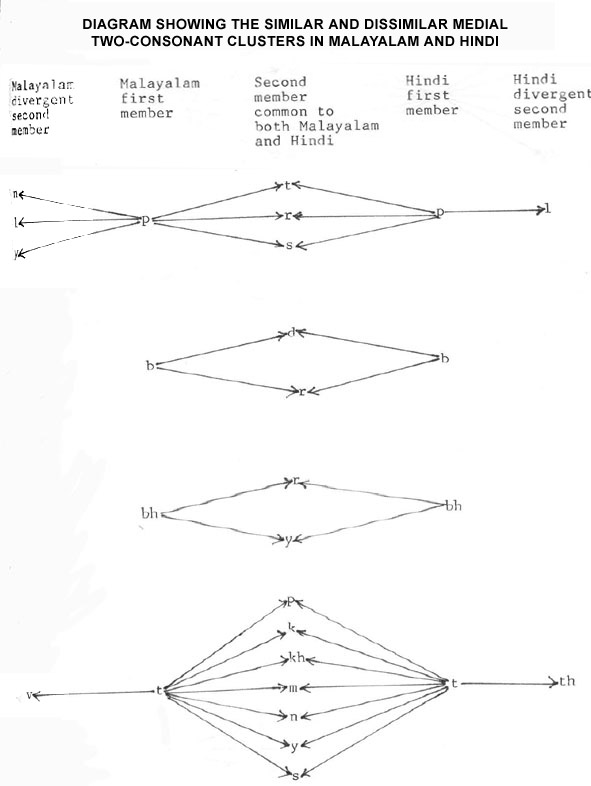
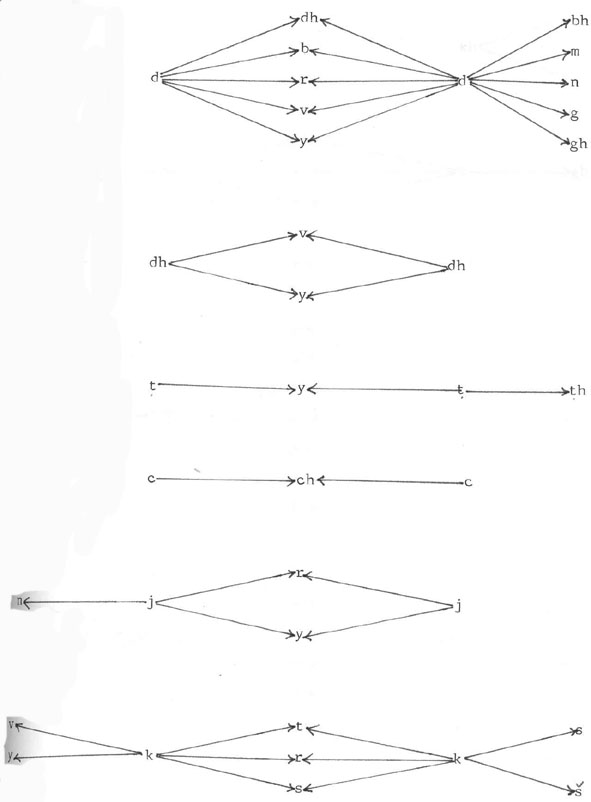
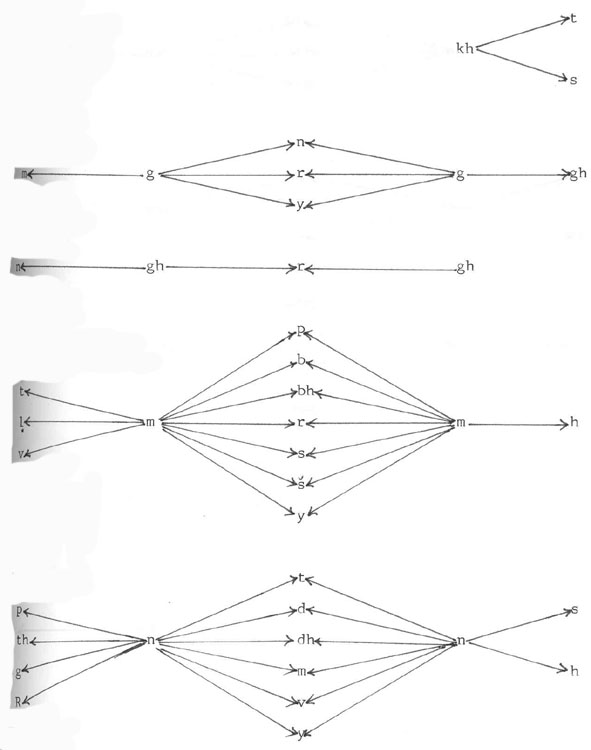
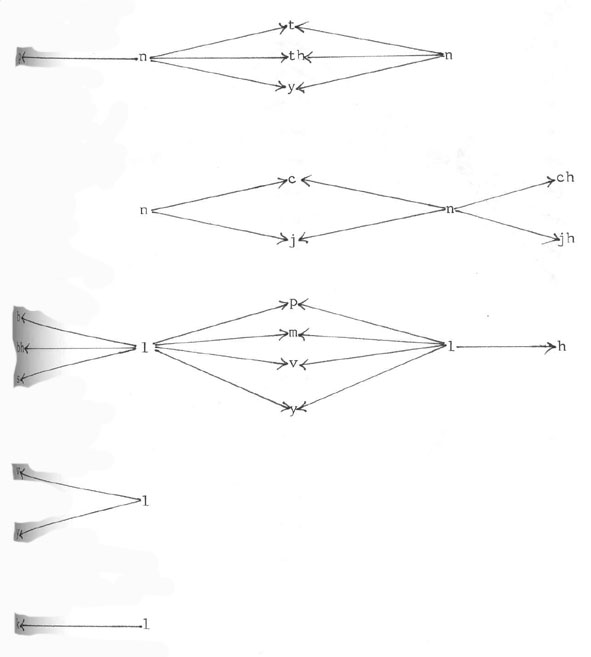
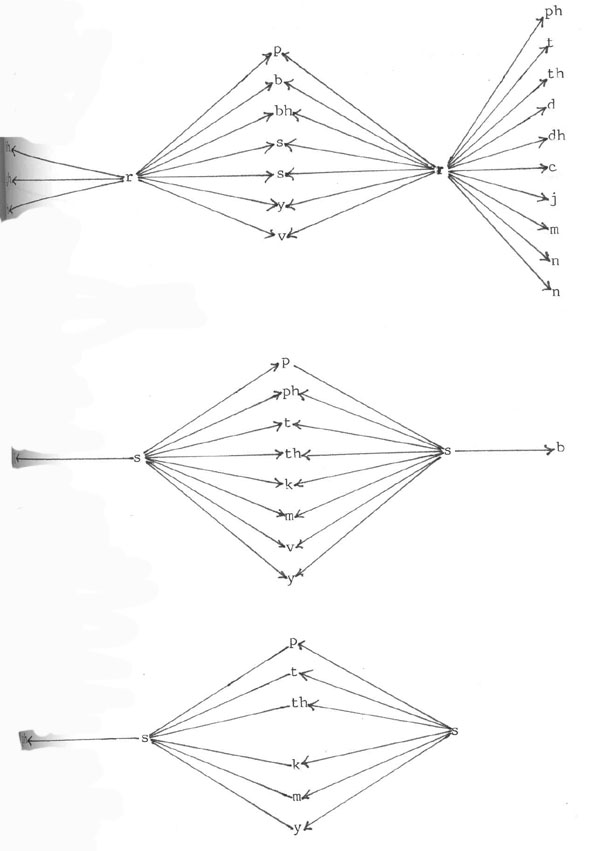
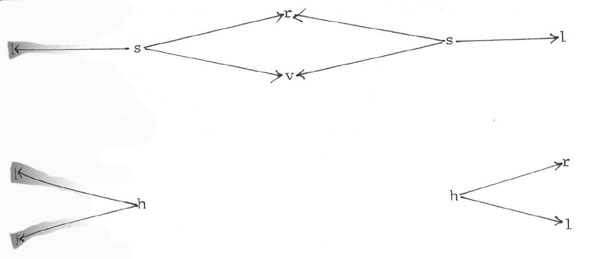
2.3.3. Final Clusters
2.3.3.1 Malayalam
In Malayalam there is no word final clusters.
2.3.3.2. Hindi
-pt /gupt/ 'hidden'
-pht /mupht/ 'free'
-bdh /upalabdh/ 'acquired'
-bhr /adabhr/ 'exceeding'
-bhy /upalabhy/ 'avialable'
-tph /lutph/
-tm /khatm/
-tr /citr/ 'picture'
-ts /bhi:bhats/ 'cruel'
-tv /tatv/ 'principle'
-ty /saty/ 'truth'
-thy /kathy/ ‘said’
-dy /gady/ 'prose'
-dhy /ba:dhy/ 'obliged'
-Ty /na:Ty/ 'act of dancing'
-Thy /pa:Thy/ 'worth studying'
-Dhy /a:Dhy/ 'rich'
-cy /aalo:cy/ 'thinkable'
-kt /atirikt/ 'extra'
-km /hukm/ 'order'
-kr /jikr/
-kl /sakl/ 'form'
-khm /jakhm/
-khy /mukhy/ 'chief'
-khs /šakhs/ 'person'
-gdh /mugdh/ 'charming'
-gn /samlagn/ 'united'
-gy /bha:gy/ 'fortune'
-mp /kamp/ 'shivering'
-mb /avilamb/ 'delay'
-mbh /a:rambh/ 'beginning'
-mr /umr/ 'age'
-mš /adhika:mš/ 'majority'
-ms /kams/ 'bronze'
-nt /turant/ 'sudden'
-nd /a:nand/ 'pleasure'
-ndh /kandh/ 'shoulder'
-nm /janm/ 'birth'
-ny /šu:ny/ 'empty'
- ñc /pa: ñc/ 'five'
- ñj /kañj/ 'lotus'
-lp /alp/ 'very little'
-lph /gulph/ 'ankle bone'
-lm /gulm/ 'a kind of shrub'
-lk /šulk/ 'dry'
-ly /mu:ly/ 'value'
-lv /khalv/ 'baldness of head'
-sp /dilcasp/
-st /cust/
-sth /anasth/ 'a kind of snuff'
-sj /rasj/
-sm /rasm/ 'custom'
-sy /upa:sy/ 'worthy of worship'
- št /gašt/
- šy /udde: šy/ 'intension'
-st /parišist/ 'supplementary'
-sth /kartavyanisth/ 'dutiful'
-sy /bhavisy/ 'future'
-sk /jyo:tisk/
-sm /bhi: sm/
-rt /šart/ 'condition'
-rth /pada:rth/ 'material'
-rd /dard/ 'pain'
-rc /mirc/ 'spicy'
-rj /sarj/
-rk /tark/ 'argument'
-rm /carm/ 'skin'
-rš /a:darš/ 'ideal'
-rv /pu:rv/ 'east'
-ry /ka:ry/ 'work'
-hn /cihn/ 'sign'
-vy /ka:vy/ 'a poem'
-vr /ti:vr/ 'sharp'
2.3.3.3. Similarities and dissimilarities
Word final clusters are found in Hindi only and in Malayalam they are totally absent. In Hindi the maximum number of constituents that can join together to form word final consonant cluster is there.
2.4 Syllabic structures
2.4.1. Monosyllabic
2.4.1.1. Malayalam
There are five types of syllables in monosyllabic words of Malayalam. They are:
Eg. 1. VV /i:/ 'this'
2. CVV /ni:/ 'you'
3. CCCVV /stri:/ 'lady'
4. VVC /a:n/ 'male'
5. CVVC /mi n/ 'fish'
2.4.1.2. Hindi
1. VV /a:/ 'come'
2. CV /na/ 'don’t'
3. VC /un/ 'those'
4. CVV /ve:/ 'they'
5. VVC /a:p/ 'you'
6. CVC /kam/ 'very little'
7. VCC /umr/ 'age'
8. CCVC /vrat/ 'fasting'
9. CVVC /na:m/ 'name'
10. CCVVC /pra:N/ 'life'
11. CCCVV /stri:/ 'lady'
2.4.1.3. Similarities and dissimilarities
In both Malayalam and Hindi syllables are marked by the relative prominence of the peaks. In a syllable both onset (O) and coda (C) are optional and nucleus (N) is obligatory S = (O) N (C)
The nucleus of a syllable is constituted by any vowel, short or long. There are as many syllables in a word as there are vowels. In Malayalam complex peaks are absent whereas in Hindi it is only allophonic. In Malayalam the coda of a syllable will contain only a single consonant but in Hindi coda contains one or more consonants. In both languages a minimum syllable contains the nucleus only.
On the basis of monosyllabic words five types of syllables are found to be similar in both Malayalam and Hindi. They are:
Eg. Mal Eg. Hindi
1. VV /i/ 'this' /a:/ 'come'
2. CVV /ni:/ 'you' /ve:/ 'they'
3. CCCVV /stri:/ 'lady' /stri:/ 'lady'
4. VVC /a:n/ 'male' /a:p/ 'you'
5. CVVC /mi:n/ 'fish' /na:m/ 'name'
Syllable types found only in Hindi
1. CV /na/ 'don’t'
2. VC /un/ 'those'
3. CVC /kam/ 'very little'
4. CCVC /vrat/ 'fasting'
5. VCC /umr/ 'age'
6. CCVVC /pra:N/ 'life'
2.4.2. Polysyllabic
2.4.2.1. Malayalam
In Malayalam the number of syllables in any one word may vary from one to eight. The Polysyllabic words in Malayalam are:
1. Disyllabic word
e.g. /iva/ 'these'
2. Trisyllabic word
e.g. /apa:yam/ 'danger'
3. Quadrisyllabic word
e.g. /saho:daran/ 'brother'
4. Penta syllabic word
e.g. /parila:lanam/ 'care'
5. Hexasyllabic word
e.g. /avasa:nikkuka/ 'to end'
6. Septisyllabic word
e.g. /avasa:nippikkunna/ 'ends'
7. Octosyllabic word
e.g. /paryavasa:nipppikkunnu/ ‘ending’
2.4.2.2. Hindi
In Hindi the number of syllables in one word may vary from one to six. These polysyllabic words in Hindi are,
1. Disyllabic word
e.g. /isi:/ 'this'
2. Trisyllabic word
e.g. /ciriya:/ 'bird'
3. Quadrisyllbic word
e.g. /la:bhaka:ri:/ 'Beneficial’
4. Penta syllabic word
e.g. /rajani:pati/ 'moon'
5. Hexasyllabic word
e.g. /paro:paka:rita:/ 'Benevolence’
2.4.2.3. Similarities and dissimilarities
The number of syllables in any one word may vary from one to eight in Malayalam and one to six in Hindi. The polysyllabic words in Malayalam and Hindi are,
1. Disyllabic word
M. /iva/ 'these'
H. /isi:/ 'this'
2. Trisyllabic word
M. /apa:yam/ 'danger'
H. /ciriya:/ 'bird'
3. Quadrisyllabic word
M. /saho:daran/ 'brother'
H. /la:bhaka:ri:/ 'Beneficial’
4. Penta syllabic word
M. /parila:Lanam/ 'care'
H. /rajani:pati/ 'moon'
5. Hexasyllabic word
M. /avasa:nikkuka/ 'to end'
H. /paro:paka:rita/ 'benevolence'
Polysyllabic words found only in Malayalam
1. Septisyllabic word
M. /avasa:nippikkunnu/ 'is ending'
2. Octosyllabic word
M. /paryavasa:nippikkunnu/ 'is ending ceremoniously'
2.5. Supra-segmental features
2.5.1. Intonation
2.5.1.1. Malayalam
In Malayalam stress and tone are not phonemic
Pitch levels
1. /4/ Extra high
2. /3/ High
3. /2/ Mid
4. /1/ Low
Terminal contours
/ / Rising
/ / Falling
/ / Level
There are three significant combinations of the pitch levels and terminals in Malayalam. They are,
1. Low pitch and a falling terminal.
e.g. mu:tta kuTTi '(this is my) eldest child'
2. High pitch level and rise in terminal
e.g. mu:tta kuTTi '(what is your) eldest child'
3. Mid pitch and a level terminal occurs in the middle of an utterence.
e.g. mu:tta kuTTi/ '(my) eldest child (is….)'
In Malayalam the pitch level /4/ i.e. extra high pitch occurs with vocatives.
e.g. /amme: / 'mother (voc.) '
2.5.1.2. Hindi
In Hindi the rhythm unit coincide with the intonation contour and these units are bound by terminal junctures or silence. Hindi intonation has four pitch levels and three terminal contours.
Pitch levels
1. /4/ Extra high
2. /3/ High
3. /2/ Mid
4. /1/ Low
Terminal contours
/ / Rising
/ / Falling
/ / Level
The most commonly used intonation pattern is / (2) 3 1 / in Hindi.
e.g. y > h e:k m> ka:n hæ
The other patterns are
e.g. vo: ghar ja: r ha: hæ/
'Is he going home ? '
y> hã: a:o (Command)
'come here'
y hã: a:o (appreciative tone)
'come here'
The level contour in Hindi is used mostly to express angry tone.
e.g. kya: k> ha: / 'what you said'
2.5.1.3. Similarities and dissimilarities
Intonation is defined as the variation which takes place in the pitch of the voice in connected speech. In both Hindi and Malayalam the intonation, have four pitch levels and three terminal contours. They are pitch levels – Extra high, High, Mid and Low and terminal contours – rising, falling and level. In both Malayalam and Hindi extra high pitch is used and it occurs with vocatives.
2.5.2. Juncture
2.5.2.1. Malayalam
Juncture marks the word-boundary in a sentence.
e.g.
/ra:tri#vaNTikku vannu/ 'came for asking the vehicle in the night time'
/ra:trivaNTiyakkuvannu/ 'came by night train'
However, in Malayalam there exist two types of significant word junctures – close juncture (+) and open juncture (-).
e.g. a:na + kuTTi > a:nakkuTTi ‘calf (elephant)
nalla + ka:lam > nallaka:lam 'good season'
2.5.2.2. Hindi
In Hindi juncture marks the word boundary in a sentence.
e.g.
/cala:na:/ 'cause to walk'
/cal#a:na:/ 'come by walk'
2.5.2.3. Similarities and dissimilarities
In both Malayalam and Hindi juncture marks the word boundary in a sentence and its distribution is mostly similar except for the fact that Malayalam distinguishes two types of low junctures.